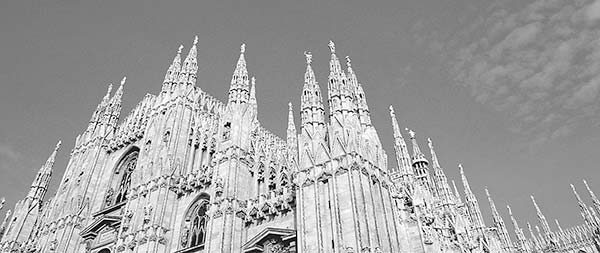
Milano
BETWEEN LA SCALA AND SFORZA CASTLE
NEAR BASILICA DI SANT’AMBROGIO
NEAR MILANO CENTRALE TRAIN STATION
Map: Milan Hotels & Restaurants
NAVIGLIO GRANDE (CANAL DISTRICT)
Map: Train Connections from Milan
For every church in Rome, there’s a bank in Milan. Italy’s second city and the capital of the Lombardy region, Milan is a hardworking, style-conscious, time-is-money city of 1.3 million. A melting pot of people and history, Milan’s industriousness may come from the Teutonic blood of its original inhabitants, the Lombards, or from its years under Austrian rule. Either way, Milan is modern Italy’s center of fashion, industry, banking, TV, publishing, and conventions. It’s also a major university town, a train hub, and host to two football (soccer) teams and the nearby Monza Formula One racetrack. And as home to a prestigious opera house, Milan is one of the touchstones of the world of opera.
Artistically, Milan can’t compare with Rome and Florence, but the city does have several unique and noteworthy sights: the Duomo and the Galleria Vittorio Emanuele II arcade, La Scala Opera House, Michelangelo’s last pietà sculpture (in Sforza Castle), and Leonardo da Vinci’s The Last Supper.
Founded by the Romans as Mediolanum (“the place in the middle”), by the fourth century AD it was the capital of the western half of the Roman Empire, the namesake of Constantine’s “Edict of Milan” legalizing Christianity, and home of the powerful early Christian bishop, St. Ambrose.
After some barbarian darkness, medieval Milan became a successful mercantile city, eventually rising to regional prominence under the Visconti and Sforza families. The mammoth cathedral, or Duomo, is a testament to the city’s wealth and ambition. By the time of the Renaissance, Milan was nicknamed “the New Athens,” and was enough of a cultural center for Leonardo da Vinci to call it home. Then came 400 years of foreign domination (under Spain, Austria, France, more Austria). Milan was a focal point of the 1848 revolution against Austria and helped lead Italy to unification in 1870. The impressive Galleria Vittorio Emanuele II and La Scala Opera House reflect the sophistication of turn-of-the-20th-century Milan as one of Europe’s cultural powerhouses.

Mussolini left a heavy fascist touch on the architecture here (such as the central train station). His excesses also led to the WWII bombing of Milan. But the city rose again. The 1959 Pirelli Tower (the skinny skyscraper in front of the station), while a trendsetter in its day, now seems quaint considering Milan’s glassy new high-rise developments. Today, Milan is people-friendly, with a great transit system and inviting pedestrian zones.
Many tourists come to Italy for the past. But Milan is today’s Italy. In this city of refined tastes, window displays are gorgeous, cigarettes are chic, and even the cheese comes gift-wrapped. Yet, thankfully, Milan is no more expensive for tourists than any other Italian city.
For pleasant excursions nearby, consider visiting Lake Como or Lake Maggiore—both are about an hour from Milan by train (see the previous chapter).
Milan isn’t as charming as Venice or Florence, but it’s still a vibrant and vital piece of the Italian puzzle.
With two nights and a full day, you can gain an appreciation for the city and see most major sights. On a short visit, I’d focus on the center. Tour the Duomo, hit any art you like (reserve ahead to see The Last Supper), browse elegant shops and the Galleria Vittorio Emanuele II, and try to see an opera. To maximize your time in Milan, use the Metro to get around.
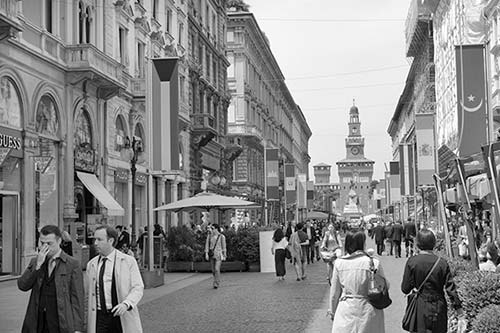
For those with a round-trip flight into Milan: I’d recommend starting your journey softly by going first to Lake Como (one-hour ride to Varenna). Then, with jet lag under control, dive into Milan.
Monday is a terrible sightseeing day, since many museums are closed (including The Last Supper). August is oppressively hot and muggy, and locals who can vacate do, leaving the city quiet. Those visiting in August find that the nightlife is sleepy, and many shops and restaurants are closed.
A Three-Hour Tour: If you’re just changing trains at Milan’s Centrale station (as, sooner or later, you probably will), consider catching a later train and taking this blitz tour: Check your bag at the station, ride the subway to the Duomo, peruse the square, explore the cathedral’s rooftop terraces and interior, drop into the Duomo Museum, have a scenic coffee in the Galleria Vittorio Emanuele II, spin on the floor mosaic of the bull for good luck, maybe see a museum (most are within a 10-minute walk of the main square), and return by subway to the station. A practical way to make the most of this quick visit is to use my free  Duomo neighborhood audio tour—see here.
Duomo neighborhood audio tour—see here.
My coverage focuses on the old center. Most sights and hotels listed are within a 15-minute walk of the cathedral (Duomo), which is a straight eight-minute Metro ride from the Centrale train station.
Milan’s TI, at the La Scala end of the Galleria Vittorio Emanuele II, isn’t worth a special trip (Mon-Fri 9:00-19:00, Sat-Sun until 18:00, Metro: Duomo, tel. 02-884-55555, www.turismo.milano.it).
For arrival by plane, see “Milan Connections” at the end of this chapter.
Visitors disembark at one of three major train stations: Milano Centrale, Porta Garibaldi, or Cadorna. Centrale handles most Trenitalia and Italo trains as well as airport buses. Porta Garibaldi receives trains from France and some Trenitalia trains from elsewhere in Italy. Both Centrale and Cadorna are terminals for trains from Malpensa Airport.
This huge, sternly decorated, fascist-built (in 1931) train station is a sight in itself. Notice how the monumental halls and art make you feel small—emphasizing that a powerful state is a good thing. In the front lobby, heroic people celebrate “modern” transportation (circa-1930 ships, trains, and cars) opposite reliefs depicting old-fashioned sailboats and horse carts.
Moving walkways link the station’s three main levels: platforms and eateries on top, shops and more food on a small mezzanine, and most services at ground level (including pay WCs and ATMs). For baggage check (deposito bagagli), taxis, or buses to Linate Airport, head toward the ground-level exit marked Piazza Luigi di Savoia. For buses to Malpensa Airport, head to the exit marked Piazza IV Novembre. Outside the station’s front entrance, under the atrium, are car-rental offices for Avis, Budget, and Maggiore, and a post office-run ATM. You’ll also find escalators down to the Metro and a fourth basement level with a few shops, including a Sapori & Dintorni supermarket.
To buy train tickets, follow blue signs to Biglietti and use the Trenitalia or Italo machines for most domestic trips. For international tickets or complicated questions, join the line at the Trenitalia ticket office on the ground floor. There’s also an Italo office on the ground floor.
Getting to the Center: “Centrale” is a misnomer—the Duomo is a 35-minute walk away. But it’s a straight shot on the Metro (8 minutes). Buy a ticket at a kiosk or from the machines, follow signs for yellow line 3 (direction: San Donato), and go four stops to the Duomo stop. You’ll surface facing the cathedral.
Taxis to the center are a good value for two or more people or if you don’t want to lug bags on the Metro (€12-15, departing taxis are to the left of the train station).
You’re most likely to use this commuter station if you take the Malpensa Express airport train, which uses track 1. The Cadorna Metro station—with a direct connection to the Duomo on Metro red line 1—is directly out front.
Some Trenitalia trains and the high-speed TGV from Paris use Porta Garibaldi station, north of the city center. Porta Garibaldi is on Metro green line 2, two stops from Milano Centrale, and purple line 5.
Leonardo never drove in Milan. Smart guy. Driving here is bad enough to make the €30/day fee for a downtown garage a blessing. And there’s a €5 congestion fee if you drive in the city center on weekdays. Do Milan (and Lake Como) before or after you rent your car, not while you’ve got it, and use the park-and-ride lots at suburban Metro stations such as Cascina Gobba. These are shown on the official Metro map, and full details are at www.atm.it (select English, then “Car Parks,” then “Parking Lots”).
Theft Alert: Be on guard. Milan’s thieves target tourists, especially at the Centrale train station, getting in and out of the subway, and around the Duomo. They can be dressed as tourists, businessmen, or beggars, or they can be gangs of too-young-to-arrest children. Watch out for ragged people carrying newspapers and cardboard—they’ll thrust these at you as a distraction while they pick your pocket. If you’re ripped off and plan to file an insurance claim, fill out a report with the police (main police station, “Questura,” Via Fatebenefratelli 11, Metro: Turati, open daily 24 hours, tel. 02-62261).
Medical Help: Here are two medical clinics with emergency care facilities (both closed Sat-Sun): the International Health Center in Galleria Strasburgo (also does dentistry, between Via Durini and Corso Europa, at #3, third floor, Metro: San Babila, tel. 02-7634-0720, www.ihc.it), and the American International Medical Center at Via Mercalli 11 (Metro: Missori or Crocetta, call for appointment, tel. 02-5831-9808, www.aimclinic.it).
Bookstores: The handiest major bookstore is La Feltrinelli, under the Galleria Vittorio Emanuele II (daily, tel. 02-8699-6903). The American Bookstore is at Via Manfredo Camperio 16, near Sforza Castle (closed Sun, Metro: Cairoli, tel. 02-878-920).
Events and Entertainment: HelloMilano.it, WantedinMilan.com, and Turismo.milano.it are decent websites for info on what’s happening in the city.
Soccer: For a dose of Europe’s soccer mania (which many believe provides a necessary testosterone vent to keep Europe out of a third big war), catch a match while you’re here. A.C. Milan and Inter Milan are the ferociously competitive home teams. Both teams play in the 85,000-seat Meazza Stadium (a.k.a. San Siro) most Sunday afternoons from September to June (ride Metro purple line 5 to San Siro Stadio, bring passport for security checks, www.acmilan.com or www.inter.it).
By Public Transit: It’s a pleasure to use Milan’s great public transit system, called ATM (“ATM Point” info desk in Duomo Metro station, www.atm.it). The clean, spacious, fast, and easy Metro zips you nearly anywhere you may want to go, and trams and city buses fill in the gaps. The handiest Metro line for a quick visit is the yellow line 3, which connects Centrale station to the Duomo. The other lines are red (1), green (2), and purple (5). The Metro shuts down at about midnight, but many trams continue until 1:00 or 2:00. With 100 miles of track, Milan’s classic, century-old yellow trams are both efficient and atmospheric.
A single ticket, valid for 90 minutes, can be used for one ride, including transfers, on Metro, bus, or tram (€2; sold at newsstands, tobacco shops, shops with ATM sticker in window, at machines in subway stations, and at many hotel reception desks). Other ticket options include a 24-hour pass (€7) and a 3-day pass (€12). Tickets must be run through the machines at Metro turnstiles when you enter and again when you leave the station. On buses and trams, the machines are at the front and rear and you need only validate upon entry. You also need to validate if transferring.
By Taxi: Small groups go cheap and fast by taxi (drop charge—€3.30, €1.10/kilometer; €5.40 drop charge on Sun and holidays, €6.50 from 21:00 to 6:00 in the morning). It can be easier to walk to a taxi stand than to flag down a cab. Handy stands are at Piazza del Duomo and in front of Sforza Castle. Hotels and restaurants are also happy to call one for you (tel. 02-8585 or 02-6969). The FreeNow app (www.free-now.com) lets you summon and pay for a taxi. Uber Black and UberLux also operate in Milan.

By Bike: Public BikeMi stations are generally near Metro stations. Download the BikeMi app to see available bikes and parking spots (subscription is €4.50/day, €9/week; first 30 minutes free, then €0.50/30 minutes up to 2 hours, after that €2/hour, www.bikemi.com).
 To sightsee on your own, download my free Milan’s Duomo Neighborhood audio tour.
To sightsee on your own, download my free Milan’s Duomo Neighborhood audio tour.
Lorenza Scorti is a hardworking young guide who knows her city’s history and how to teach it. She also enjoys leading Lake Como day trips (€160/3 hours, same price for individuals or groups, evenings OK, mobile 347-735-1346, lorenza.scorti@libero.it). Sara Cerri is another good licensed local guide who enjoys passing on her knowledge (€195/3 hours, then €50/hour, mobile 380-433-3019, www.walkingtourmilan.it, walkingtourmilan@gmail.com). Valeria Andreoli, smart and fun-loving, leads a variety of themed tours (highlights tour—€60/hour, €180/half-day, mobile 338-301-2220, www.bellamilanotours.com, valeria@bellamilanotours.com).
If you can’t get a reservation for The Last Supper, consider joining a walking or bus tour that includes a guided visit to Leonardo’s masterpiece. These €65-80 tours (usually 3 hours) also take you to top sights such as the Duomo, Galleria Vittorio Emanuele II, La Scala Opera House, and Sforza Castle. Ideally book at least a week in advance, but it’s worth a try at the last minute, too.
For the best experience, I’d book a walking tour with Veditalia (www.veditalia.com) or City Wonders (www.citywonders.com). Both have good guides and solid reputations. Get Your Guide (www.getyourguide.com) is another worthwhile option. The bus-and-walking tours are less satisfying, but you can try Autostradale (“Look Mi” tour, offices in passage at far end of Piazza del Duomo and in front of Sforza Castle, tel. 02-8058-1354, www.autostradaleviaggi.it) or Zani Viaggi (office disguised as a “tourist information” point, corner of Foro Buonaparte and Via Cusani at #18, near Sforza Castle, tel. 02-867-131, www.zaniviaggi.com).
Hop-On, Hop-Off Option: Zani Viaggi also operates CitySightseeing Milano hop-on, hop-off buses (look for the red buses—easiest at Duomo and La Scala, €22/all day, €25/48 hours, buy on board, recorded commentary, www.milano.city-sightseeing.it). With the 48-hour bus ticket, you can pay an additional €44 for a Last Supper reservation—exorbitant but worth considering for the wealthy and the desperate (April-Oct only).
▲▲Duomo Museum (Museo del Duomo)
▲▲Galleria Vittorio Emanuele II
▲La Scala Opera House and Museum
Performances in the Opera House
Piazza degli Affari and a Towering Middle Finger
▲Church of San Maurizio (San Maurizio al Monastero Maggiore)
▲Leonardo da Vinci National Science and Technology Museum (Museo Nazionale della Scienza e Tecnica “Leonardo da Vinci”)
▲▲Leonardo da Vinci’s The Last Supper (L’Ultima Cena/Cenacolo Vinciano)
▲▲Brera Art Gallery (Pinacoteca di Brera)
▲▲Sforza Castle (Castello Sforzesco)
Sempione Park (Parco Sempione)
▲Naviglio Grande (Canal District)
▲Monumental Cemetery (Il Cimitero Monumentale)
Milan’s core sights—the Duomo, Duomo Museum, and Galleria Vittorio Emanuele II—cluster within easy walking distance. Also in the Duomo area are the Piazza della Scala and La Scala Opera House.
The city’s other main sights—The Last Supper, Basilica di Sant’Ambrogio, Sforza Castle, and Brera Art Gallery—are scattered farther afield. It’s easiest to reach them by public transportation.
The city’s centerpiece is the third-largest church in Europe (after St. Peter’s Basilica in Rome and Sevilla’s cathedral). At 525 by 300 feet, the place is immense, with more than 2,000 statues inside (and another thousand outside) and 52 100-foot-tall, sequoia-size pillars representing the weeks of the year and the liturgical calendar. If you do two laps, you’ve done your daily walk. The church was built to hold 40,000 worshippers—the entire population of Milan when construction began.
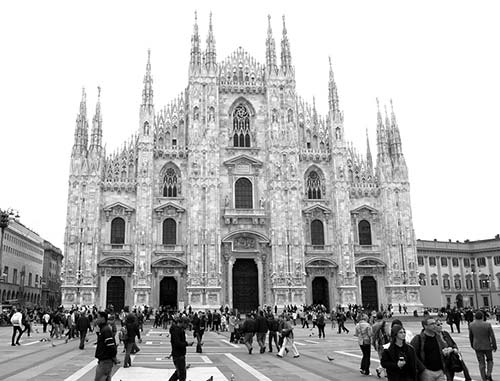
A visit here has several elements. First, take in the overwhelming exterior from various angles, admiring its remarkable bulk and many spires and statues. Then go inside to see the church’s vast nave, stained glass, historic tombs, basement archaeological area, and a quirky, one-of-a-kind statue of a flayed man. A visit to the adjacent Duomo Museum lets you see the church’s statues and details up close. Finally, take an elevator ride (or long stair climb) up to the Duomo rooftop for city views and a stroll through a forest of jagged church spires.
Cost: Cathedral-€3, museum-€3, rooftops by elevator-€14. The archaeological area is free with any ticket. Of the various combo-tickets, the best is the €17 Duomo Pass Lift, which includes the cathedral, rooftop terraces by elevator, archaeological area, and Duomo Museum.
Hours: Cathedral open daily 8:00-19:00, archaeological area and rooftop from 9:00; Duomo Museum Thu-Tue 10:00-18:00, closed Wed; last entry one hour before closing.
Information: Church tel. 02-7202-3375, museum tel. 02-3616-9351, www.duomomilano.it.

Buying Tickets and Avoiding Lines: There are two ticket booths (each with ticket machines): the big ticket center with info office (on the south side of the cathedral across from the Duomo’s right transept at #14a) and at the Duomo Museum.
You can avoid the occasionally very long ticket lines by buying timed-entry tickets online (€0.50/ticket surcharge); if buying on-site, the museum often has shorter lines. Security lines can also be long. You can avoid the church security line by doing the rooftop first and descending from there directly into the church. Or visit late in the day, when there are generally fewer people.
Dress Code: Modest dress is required to visit the church. Keep shoulders and knees covered, and don’t wear sports T-shirts or shorts.
Tours: A €6 audioguide for the church is available at a kiosk inside its main door (no rentals Sun).
 Self-Guided Tour
Self-Guided TourStand facing the main facade. The Duomo is huge and angular, with prickly spires topped with statues. The style, Flamboyant Gothic, means “flame-like,” and the church seems to flicker toward heaven with flames of stone. The facade is a pentagon, divided by six vertical buttresses, all done in pink-white marble. The dozens of statues, pinnacles, and pointed-arch windows on the facade are just a fraction of the many adornments on this architecturally rich structure.
For more than 2,000 years, this spot has been the spiritual heart of Milan: In 2014, archaeologists probing for ancient Roman ruins beneath the Duomo discovered the remains of what might be a temple to the goddess Minerva. A church has stood on this site since the days of the ancient Romans and St. Ambrose (4th century), but construction of the building we see today began in 1386. Back then, the dukes of Milan wanted to impress their counterparts in Germany, France, and the Vatican with this massive cathedral. They chose the trendy Gothic style coming out of France, and stuck with it even after Renaissance-style domes came into vogue elsewhere in Italy. The cathedral was built not from ordinary stone, but from expensive marble, top to bottom. Pink Candoglia marble was rafted in from a quarry about 60 miles away, across Lake Maggiore and down a canal to a port at the cathedral—a journey that took about a week. Construction continued from 1386 to 1810, with final touches added as late as 1965.
The statues on the lower level of the facade—full of energy and movement—are early Baroque, from about 1600. Of the five bronze doors, the center one is biggest. Made in 1907 in the Liberty Style (Italian Art Nouveau), it features the Joy and Sorrow of the Virgin Mary. Sad scenes are on the left, joyful ones on the right, and on top is the coronation of Mary in heaven by Jesus, with all the saints and angels looking on. (High above that is what looks like the Statue of Liberty, dating from the 1820s—decades before Frédéric-Auguste Bartholdi designed the one Americans know and love. Hmmm.)
Topping the church (you may have to back up to see it) is its tallest spire. It rises up from the center of the Duomo to display a large golden statue of the Madonna of the Nativity, to whom the church is dedicated.
A Closer Look: Along the right side of the church are interesting views from every angle: the horizontal line of the long building, the verticals of the spires, and the diagonals of the flying buttresses supporting the roof. Get close to the facade’s right corner to appreciate the many intricate details: a nude Atlas holding up the corner buttress, robed saints, relief panels of Bible scenes, and tiny faces—angry, smiling, happy, sad.
Stroll a little farther down the right to see the range of statues, from placid saints to thrashing nudes. These statues were made between the 14th and 20th centuries by sculptors from all over Europe. There are hundreds of them—each different. Midway up are the fanciful gargoyles (96 in total) that functioned as drain spouts. Look way up to see the statues on the tips of the spires...they seem so relaxed, like they’re just hanging out, waiting for their big day.
The back end of the church (if you make it that far) is the oldest part, with the earliest stones, laid in the late 1300s. The sun-in-rose window was the proud symbol of the city’s leading Visconti family. It’s flanked by the angel telling Mary she’s going to bear the Messiah. Nearby, find the shrine to the leading religion of the 21st century: soccer. The Football Team store is filled with colorful vestments and relics of local soccer saints.
Nave: It’s the fourth-longest nave in Christendom, stretching more than 500 feet from the entrance to the stained-glass rose window at the far end. The apse at the far end was started in 1385. The wall behind you wasn’t finished until 1520. The style is Gothic, a rarity in Italy. Fifty-two tree-sized pillars rise to support a ribbed, pointed-arch ceiling, and the church is lit by glorious stained glass. At the far end, marking the altar, is a small tabernacle of a dome atop columns—a bit of an anomaly in a Gothic church (more on that later). Notice the little red light on the cross high above the altar. This marks where a nail from the cross of Jesus is kept. This relic was brought to Milan by St. Helen (Emperor Constantine’s mother) in the fourth century, when Milan was the capital of the western Roman Empire. It’s on display for three days a year (in mid-Sept).
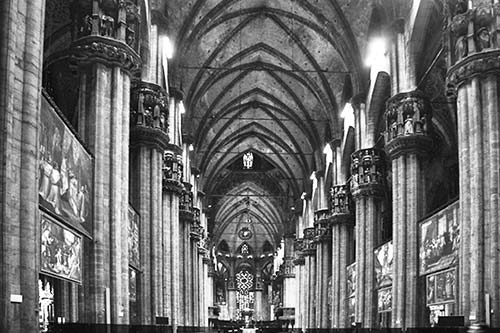
Notice the two single-stone pillars flanking the main door—each is made from a single stone. Now, facing the altar, look high to the right, in the rear corner of the church, and find a tiny pinhole of white light. This is designed to shine a 10-inch sunbeam at noon onto the bronze line that runs across the floor, indicating where we are on the zodiac calendar.
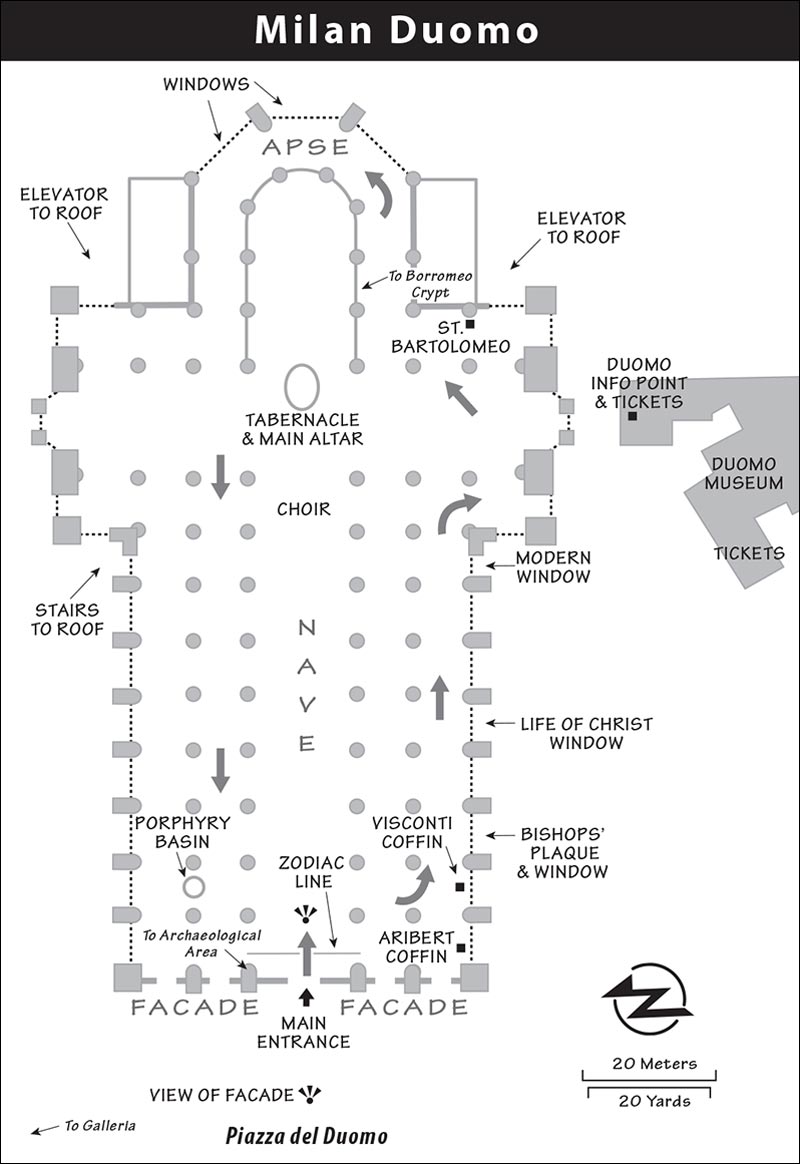
This 600-year-old church is filled with history. It represents the continuous line of bishops who have presided over Milan, stretching back to the days of St. Ambrose (c. 340-397). Let’s see some of the earliest artifacts.
• Before wandering deeper into the church, head to the end of the...
Right Aisle: The first recess along the right wall has the 1,000-year-old gray-stone coffin of Archbishop Aribert, a formidable figure in 11th-century Milan. A couple of steps farther along, you’ll see a red coffin atop columns belonging to the noble Visconti family who commissioned this church.
The third bay has a plaque where you can trace the uninterrupted rule of 144 local archbishops back to AD 51. Check out the stained-glass window above the plaque. Find familiar scenes along the window’s bottom level: Cain killing Abel, the Flood, and the drunkenness of Noah. The brilliant and expensive colored glass (stained, not painted) is from the 15th century. Bought by wealthy families seeking the Church’s favor, the windows face south to get the most light. The windows’ purpose was to teach the illiterate masses the way to salvation through stories from the Old Testament and the life of Jesus. Many of the windows are more modern—from the 16th to the 20th century—and are generally made of dimmer, cheaper painted glass. Many are replacements for ones destroyed by the concussion of WWII bombs that fell nearby.
The fifth window dates from 1470, “just” 85 years after the first stone of the cathedral was laid. The window shows the story of Jesus, from Annunciation to Crucifixion. In the bottom window, as the angel Gabriel tells Mary the news, the Holy Spirit (in the form of a dove) enters Mary’s window and world.
The seventh window is from the 1980s. Bright and bold, it celebrates two local cardinals (whose tombs and bodies are behind glass). The memorials to Cardinal Ferrari (below the window) and Cardinal Schuster (in the next bay), who heroically helped the Milanese out of their post-WWII blues, are a reminder that this great church is more than a tourist attraction—it’s a living part of Milan.
• Now take a few steps back into the nave for a view of the...
Main Altar: The altar area is anchored by the domed tabernacle atop columns. This houses the receptacle that holds the Eucharist. Flanking the tabernacle are two silver statues of famous bishops. On the left is St. Ambrose, the influential fourth-century bishop who put Milan on the map and became the city’s patron saint. The other is St. Charles Borromeo, the bishop who transformed the Duomo in the 16th century. Charles had inherited a cathedral that was barely half-finished. He re-energized the project, and commissioned the tabernacle. Above are four 16th-century pipe organs.
While the rest of the church is Gothic, the altar is Baroque—a dramatic stage-like setting in the style of the Vatican in the 1570s. Borromeo was a great champion of the Catholic church, and this powerful style was a statement to counter the Protestant Reformation that was threatening the Roman Catholic Church. Look up into the dome above the altar—a round dome on an octangular base, rising 215 feet. Napoleon crowned himself king of Italy under this dome in 1805. It was Napoleon who sped up construction, so that in 1810—finally—the church was essentially completed.
• Before moving on, look to the rear, up at the ceiling, and see the fancy “carved” tracery on the ceiling’s ribs. Nope, that’s painted. It looks expensive, but paint is more affordable than carved stone. Now continue up the right aisle and into the south (right) transept. Find the bald statue.
St. Bartolomeo Statue: This is a grotesque 16th-century statue of St. Bartolomeo, an apostle and first-century martyr skinned alive by the Romans. Examine the details (face, hands, feet) of the poor guy. He piously holds a Bible in one hand and wears his own skin like a robe. Carved by a student of Leonardo da Vinci, this is a study in human anatomy learned by dissection, forbidden by the Church at the time. Read the sculptor’s proud Latin inscription on the base: “I was not made by Praxiteles”—the classical master of beautiful nudes—“but by Marco d’Agrate.”
• Walk toward the altar, checking out the fine 16th-century inlaid-marble floor. The black marble (quarried from Lake Como) is harder and more durable, while the lighter colors (white from Lake Maggiore, pink from Verona) look and feel more worn. At the altar, bear right around the corner 15 steps. You’ll see a door marked Scurolo di S. Carlo. This leads down to the...
Crypt of St. Charles Borromeo: Steps lead under the altar to the tomb of St. Charles Borromeo (1538-1584), the economic power behind the church. You can still see Charles’ withered body inside the rock-crystal coffin. Charles was bishop of Milan, and the second most important hometown saint after St. Ambrose. Tarnished silver reliefs around the ceiling show scenes from Charles’ life.
• Now resurface and continue around the apse, looking up at the...
Windows: The apse is lit by three huge windows, all 19th-century painted copies. The originals, destroyed in Napoleonic times, were made of precious stained glass. Each window has 12 panels and 12 rows, creating 144 separate scenes.
• From the apse, head back through the church toward the main entrance. Near the entrance stands a large basin of expensive purple porphyry. Made by Borromeo’s favorite architect, Pellegrini, it was used to baptize infants. Now find the entrance and stairs that lead down to the...
Archaeological Area: The church’s “basement” is a maze of ruined brick foundations of earlier churches that stood here long before the present one. Milan has been an important center of Christianity since its beginning. In Roman times, Mediolanum’s streets were 10 feet below today’s level. The stones and mosaics you see, the pavement you walk on, and the artifacts in the glass case date from the time of the Edict of Milan (AD 313) when Emperor Constantine, ruling from this city, made Christianity legal in the Roman Empire.
The highlight here is the scant remains of the eight-sided Paleo-Christian Baptistery of San Giovanni. It stands alongside the remains of a little church. Back then, since you couldn’t enter the church until you were baptized (which didn’t happen until age 18), churches had a little baptistery just outside for the unbaptized.
This humble baptistery was where St. Ambrose was baptized. Ambrose went on to become bishop here, and to mentor a randy and rebellious Roman named Augustine. On this spot in AD 387, Ambrose baptized the 31-year-old Augustine of Hippo, who later became one of Christianity’s (and the world’s) most influential thinkers, philosophers, and writers. And the rest—like this tour—is history.
For information on tickets and opening times for these sights, see the cost and hours for the Duomo, earlier.
This museum, to the right of the Duomo in the Palazzo Reale, helps fill in the rest of the story of Milan’s cathedral, and lets you see its original art and treasures up close. The collection is much more meaningful with the audioguide (€6, with standard earbud jack).
Visiting the Museum: Just after the ticket taker, notice (on the wall to your right) the original inlaid-marble floor of the Duomo. The black (from Lake Como) marble is harder. Go ahead, wear down the white a little more.
Now follow the roughly chronological one-way route. Among the early treasures of the cathedral is a 900-year-old, Byzantine-style crucifix. Made of copper gilded with real gold and nailed onto wood, it was part of the tomb of the archbishop of Milan. A copy is in today’s cathedral.
You’ll pass a big, wooden model of the church (we’ll get a better look at this later, on the way out). Then you’ll step through a long room with paintings, chalices, glass monstrances, and lifelike reliquary busts of Sts. Charles, Sebastian, and Thecla.
Look for the big, 600-year-old statue of St. George. Among the cathedral’s oldest statues, it once stood on the front (and first constructed) spire of the Duomo. Some think this is the face of Duke Visconti—the man who started the cathedral. The museum is filled with statues and spires like this, carved of marmo di Candoglia—marble from Candoglia. The duke’s family gave the entire Candoglia quarry (near Stresa) to the church for all the marble it would ever need.
You’ll pop into a long room filled with more statues. On your left, gaze into the eyes of the big gilded bust of God the Father. Made of wood, wrapped in copper, and gilded, this giant head covered the keystone connecting the tallest arches directly above the high altar of the Duomo.
Continue into a narrow room lined with grotesque gargoyles. When attached to the cathedral, they served two purposes: to scare away evil spirits and to spew rainwater away from the building.
Twist through several more rooms of 14th- and 15th-century statues big and small that embellished the church’s many spires. In one long, brick-walled hall, watch on the left for St. Paul the Hermit, who got close to God by living in the desert. While wearing only a simple robe, he’s filled with inner richness. The intent is for pilgrims to commune with him and feel at peace (but I couldn’t stop thinking of the Cowardly Lion—“Put ’em up! Put ’em up!”).
A few steps beyond Paul, look for the 15th-century dandy with the rolled-up contract in his hand. That’s Visconti’s descendant, Galeazzo Sforza, and if it weren’t for him, the church facade might still be brick as bare as the walls of this room. The contract he holds makes it official—the church now owns the marble quarry (and it makes money on it to this day).
In the next room, study the brilliantly gilded and dynamic statue God the Father (1554). Five steps farther is a sumptuous Flanders-style tapestry, woven of silk, silver, and gold in 1468. Half a millennium ago, this hung from the high altar. In true Flemish style, it weaves vivid details of everyday life into the theology. It tells the story of the Crucifixion by showing three scenes at once. Note the exquisite detail, down to the tears on Mary’s cheeks.
Next you’ll step through a stunning room with 360 degrees of gorgeous stained glass from the 12th to 15th century, telling the easily recognizable stories of the Creation, the Tower of Babel, and David and Goliath. Take a close look at details that used to be too far above the cathedral floor to be seen clearly—again, designed for God’s eyes only.
Farther on, you’ll reach a display of terra-cotta panels juxtaposed with large monochrome paintings (1628) by Giovanni Battista Crespi. After Crespi finished the paintings, they were translated into terra-cotta, and finally sculpted in marble to decorate the doorways of the cathedral. Study Crespi’s Creation of Eve (Creazione di Eva) and its terra-cotta twin. This served as the model for the marble statue that still stands above the center door on the church’s west portal (1643). You’ll pass a few more of these scenes, then hook into a room with the original, stone-carved, swirling Dancing Angels, which decorated the ceiling over the door.
• When you reach the doors leading into the museum shop, make a U-turn to see the final exhibits.
After passing several big tapestries, and a huge warehouse where statues are stacked on shelves stretching up to the ceiling, you’ll reach the Frame of the Madonnina (1773). Standing like a Picasso is the original iron frame for the statue of the Virgin Mary that still crowns the cathedral’s tallest spire. In 1967, a steel replacement was made for the 33 pieces of gilded copper bolted to the frame. The carved-wood face of Mary (in the corner) is the original mold for Mary’s cathedral-crowning copper face.
Soon you’ll get a better look at that wooden model of the Duomo. This is the actual model used in the 16th century by the architects and engineers to build the church. This version of the facade wasn’t built, and other rejected facades line the walls.
On your way out, you’ll pass models for the Duomo’s doors. And stepping outside, as your eyes adjust to the sunlight, you’ll see the grand church itself—looking so glorious thanks to the many centuries of hard work you’ve just learned about.
Strolling between the frilly spires of the cathedral rooftop terraces is the most memorable part of a Duomo visit. You can climb the stairs or take the elevators. On the left side, the stairs are in front of the transept, and the elevator is behind it. (Even those taking the elevator will have to climb a lot of stairs.) On the right side, look for the “fast-track” elevator behind the transept.
Once up there, you’ll loop around the rooftop, wandering through a fancy forest of spires with great views of the city, the square, and—on clear days—the crisp and jagged Alps to the north. And, 330 feet above everything, La Madonnina overlooks it all. This 15-foot-tall gilded Virgin Mary is a symbol of the city.
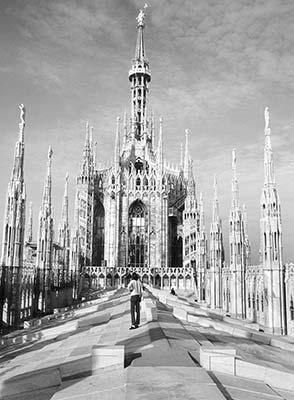
Visiting the Rooftop: As you emerge from the stairs or lift, you first walk along the lower side-terrace. You’ll enjoy close-ups of fanciful gargoyles, statue-topped spires, and ever-changing views of the rows of flying buttresses (which, on this lavishly ornamented Gothic church, are both decorative and functional).
Take a moment to appreciate the detail. Keep in mind that the stairs you climbed were designed not for the public but for workers. The exquisite figures carved in stone around you—every face and every glower all different—were unseen by the public for over 400 years. They were all carved as a gift to God.
Next you climb a richly carved staircase to the sloping rooftop—directly above the nave. As you wander among the spires, pick any one and appreciate its details. At the spires’ base is the marble “fence” that surrounds the entire rooftop, with its pointed arches topped with pinnacles, which themselves are mostly crowned with crosses. Each spire is supported by blocks of Candoglia marble, with its pink-white-green-blue hues (which blend into gray).
On the next level up, the spires have vertical ribs and saints in cages. Continuing up, they get more ornate, with flamboyant flames that flicker upward toward still more saints posing beneath church-like awnings. Finally, the spire tapers into a slender point, topped with a lifelike saint who gazes out over the city. The church has 135 spires—all similar, yet each different. No wonder it took 600 years to carve it all.
At the counter-facade (the back side of the church’s false-front facade), find a few 20th-century details that are among the last things done. To the left (as you face toward the Piazza del Duomo), find carved reliefs with boxing scenes. Just above and to the right of the boxing scenes is a relief of carved foliage. The proud-looking face peering out from the leaves is none other than the WWII dictator Benito Mussolini.
Before leaving, check out the great views of the city. To the east, you can peer down into the Piazza del Duomo, 20 stories below.
To the south of the Duomo is the red-brick, octagonal, statue-topped bell tower of San Gottardo Church, built in the 1300s by the same Visconti family that began the Duomo. The hard-to-miss Velasca Tower (Torre Velasca) is a top-heavy skyscraper from the 1950s (modeled on medieval watchtowers such as those at the Sforza Castle), which became a symbol of Milan’s rise from the ashes of World War II.
Looking north, there’s a skyline of a dozen-plus skyscrapers. At the far right of the group is the 32-story Pirelli Tower, a slender rectangle with tapering sides, which proclaimed Italy’s postwar “economic miracle.” The UniCredit Tower (from 2011), with its 750-foot-high rocket-like spire, is Italy’s tallest building, and represents Milan’s future. (This marks the Porta Nuova neighborhood, described later and worth a visit.)
Remember, as you leave you’ll find two descending staircases giving you two options: directly back to the street or into the church.
Stand in the center of Milan’s main square and take in the scene. Before you rises the massive, prickly facade of Milan’s cathedral, the Duomo. The huge equestrian statue in the center of the piazza is Victor Emmanuel II, the first king of Italy. He’s looking at the grand Galleria named for him. The words above the triumphal arch entrance read: “To Victor Emmanuel II, from the people of Milan.” This grand square is ground zero for public events, marches, and spectacles in Milan.

To the right of the Duomo are the twin fascist buildings of the Arengario Palace. Mussolini made grandiose speeches from the balcony on the left. Study the buildings’ relief panels, which tell—with fascist melodrama—the history of Milan. Today the palace houses the Museo del Novecento (described later).
Directly to the right of the Duomo is the historic ducal palace, the Palazzo Reale, which now houses the Duomo Museum (described earlier). The palace was redone in the Neoclassical style by Empress Maria Theresa in the late 1700s, when Milan was ruled by the Austrian Habsburgs.
Behind the Victor Emmanuel II statue (opposite the cathedral, about a block beyond the square), hiding in a small courtyard, is Piazza dei Mercanti, the center of medieval Milan (described later).
And all around you in Piazza del Duomo is a classic European scene and a local gathering point. Professionals scurry, fashion-forward kids loiter, and young thieves peruse.
This breathtaking four-story glass-domed arcade, next to Piazza del Duomo, is a symbol of Milan. The iron-and-glass shopping mall (built during the age of Eiffel and the heady days of Italian unification) showcased a new, modern era. It was the first building in town to have electric lighting, and since its inception it’s been an elegant and popular meeting place. (Sadly, its designer, Giuseppe Mengoni, died the day before the gallery opened.) Here, in this covered piazza, you can turn an expensive cup of coffee into a good value by enjoying some of Europe’s best people-watching.
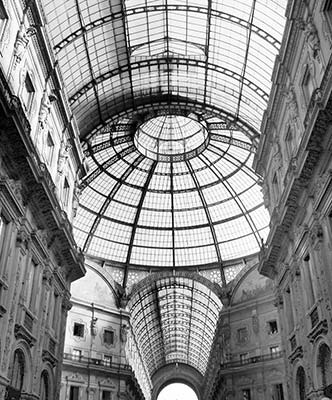
The venerable Bar Camparino (at the Galleria’s Piazza del Duomo entry), with a friendly staff and a period interior surviving from the 1870s, is the former haunt of famous opera composer Giuseppe Verdi and conductor Arturo Toscanini, who used to stop by after their performances at La Scala. It’s a fine place to enjoy a drink and people-watch (€4 for an espresso is a great deal to take a seat, relax and enjoy the view, or pay €1.50 at the bar just to experience the scene). The café is named after the Campari family (its first owners), originators of the famous red Campari bitter. You can enjoy a Campari or a Campari spritz at this unforgettable perch for €13 (Tue-Sun 7:30-20:00, closed Mon and Aug, tel. 02-8646-4435).
Wander around the Galleria. Its art celebrates the establishment of Italy as an independent country. Around the central dome, patriotic mosaics symbolize the four major continents (sorry, Australia). The mosaic floor is also patriotic. The white cross in the center is part of the king’s coat of arms. The she-wolf with Romulus and Remus (on the south side—facing Rome) honors the city that, since 1870, has been the national capital. On the west side (facing Torino, the provisional capital of Italy from 1861 to 1865), you’ll find that city’s symbol: a torino (little bull). For good luck, locals step on his irresistible little testicles. Two local girls explained to me that it works better if you spin—two times, and it must be clockwise. Find the poor little bull and observe for a few minutes...it’s a cute scene. With so much spinning, the mosaic is replaced every few years.
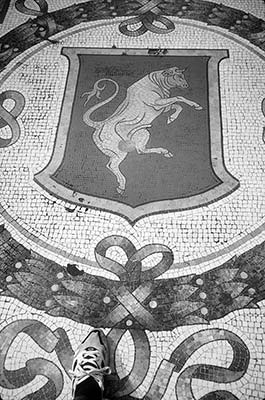
Luxury shops have had outlets here from the beginning. Along with Gucci, Louis Vuitton, and Prada, you’ll find Borsalino (at the end near Piazza della Scala), which has been selling hats here since the gallery opened in 1877.
If you cut through the Galleria to the other side, you’ll pop out at Piazza della Scala, with its famous opera house and the Gallerie d’Italia—all described later. (While you may be tempted to walk the Highline Galleria, which hangs among the Galleria Vittorio Emanuele II rooftops, it’s not worth the time or money.)
Milan’s art of the 1900s (Novecento) fills the two buildings of the Arengario Palace, Mussolini’s fascist-era City Hall. In the beautifully laid-out museum, you’ll work your way up the escalators and through the last century, one decade at a time. Each section is well-described, and the capper is a fine panoramic view over Piazza del Duomo through grand fascist-era arches. The museum makes it clear that Milan—a trendy city today—has been setting design trends since the start of the Novecento.
Cost and Hours: €10; Tue-Sun 9:30-19:30 (Thu and Sat until 22:30), Mon from 14:30; last entry one hour before closing, audioguide—€5, facing Piazza del Duomo at Via Marconi 1, tel. 02-8844-4072, www.museodelnovecento.org.
Visiting the Museum: As you spiral up the ramp, pause at the large painting, The Fourth Estate, to gaze into the eyes of proud workers getting off their shift. Painted in 1901, the work was a bold manifesto of a new era, and is a good introduction to the revolutionary spirit of the museum.
On the second floor, minor works by Picasso, Matisse, Mondrian and others are a snapshot of “Modern Art” trends around Europe as the 1900s began. Next you see how they inspired Italy’s artists. Boccioni followed northern Europe’s lead, evolving from a placid painter of realistic portraits to a bold sculptor of swirling forms. He captured a world in high-tech motion—i.e., “Futurism.”
Escalate up to the third floor to see Giorgio de Chirico’s brooding canvases of long shadows and empty architecture—Italy’s great contribution to the movement called Surrealism.
The fourth floor focuses on the actual Novecento Italiano movement of the 1920s, which was based in Milan. These artists tried to merge Italy’s classic roots (of monumental ancient Roman art and geometrically solid Renaissance art) with abstract styles and the revivalist spirit of the Mussolini years.
Continuing up to the fifth floor, you emerge into a glass-walled space (often hosting temporary installations) with great views over Piazza del Duomo. Find the stairs up to the top room, with canvases by Lucio Fontana. In the 1950s and ‘60s, Fontana made his mark by slicing and puncturing canvases to transform a two-dimensional “painting” into a three-dimensional “sculpture.” Fontana also did the room’s textured ceiling and a large neon sculpture elsewhere on floor 5.
This small square, the center of political power in 13th-century Milan, hides one block off Piazza del Duomo (directly opposite the cathedral). A strangely peaceful place today, it offers a fine smattering of historic architecture that escaped the bombs of World War II.
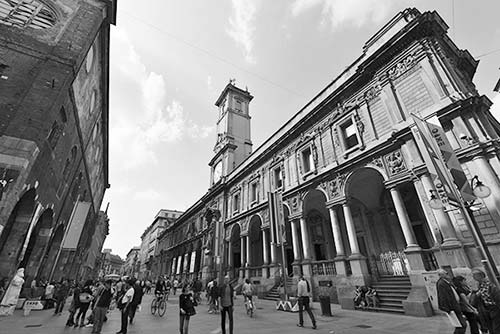
The arcaded, red-brick building that dominates the center of the square was the City Hall (Palazzo della Ragione); its arcades once housed the market hall. Overlooking the wellhead in the middle of the square is a balcony with coats of arms—this is where new laws were announced. Eventually two big families—Visconti and Sforza—took power, Medici-style, in Milan; the snake is their symbol. Running the show in Renaissance times, these dynasties shaped much of the city we see today, including the Duomo and the fortress. In 1454, the Sforza family made peace with Venice while enjoying a friendship with the Medici in Florence (who taught them how to become successful bankers). This ushered in a time of stability and peace, when the region’s major city-states were run by banking families, and money was freed up for the Renaissance generation to make art, not war.
This square also held the Palace of Justice (the 16th-century courthouse with the clock tower), the market (not food, but crafts: leather, gold, and iron goods), the bank, the city’s first university, and its prison. All the elements of a great city were right here on the “Square of the Merchants.”
To reach these sights, cut through the Galleria Vittorio Emanuele II from Piazza del Duomo.
This smart little traffic-free square, between the Galleria and the opera house, is dominated by a statue of Leonardo da Vinci. The statue (from 1870) is a reminder that Leonardo spent his best 20 years in Milan, where he found well-paid, steady work. He was the brainy darling of the Sforza family (who dominated Milan as the Medici family dominated Florence). Under the great Renaissance genius stand four of his greatest “Leonardeschi.” (He apprenticed a sizable group of followers.) The reliefs show his various contributions as a painter, architect, and engineer. Leonardo, wearing his hydro-engineer hat, reengineered Milan’s canal system, complete with locks. (Until the 1920s, Milan was one of Italy’s major ports, with canals connecting the city to the Po River and Lake Maggiore. For more on this footnote of Milan’s history, read about the Naviglio Grande on here.)
The statue of Leonardo is looking at a plain but famous Neoclassical building, arguably the world’s most prestigious opera house (described next).
Milan’s famous Teatro alla Scala opened in 1778 with an opera by Antonio Salieri (Mozart’s wannabe rival). Today, opera buffs can get a glimpse of the theater and tour the adjacent museum’s extensive collection, featuring Verdi’s top hat, Rossini’s eyeglasses, Toscanini’s baton, Fettuccini’s pesto, original scores, diorama stage sets, busts, portraits, and death masks of great composers and musicians. For true devotees, La Scala is the Mecca of the religion of opera.
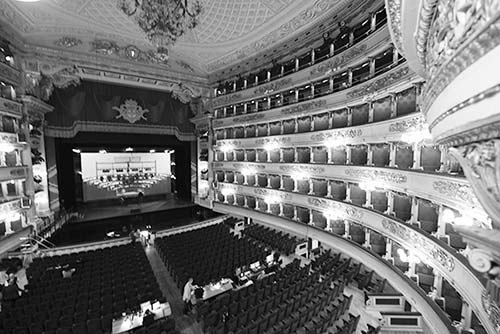
Cost and Hours: €9, daily 9:00-17:30, Piazza della Scala, tel. 02-8879-7473, www.teatroallascala.org.
Visiting the Museum: The main reason to visit the museum is the opportunity to peek into the theater (on many mornings you’ll see the orchestra practicing). The stage is as big as the seating area on the ground floor. (You can see the towering stage box from Piazza della Scala across the street.) A renovation corrected acoustical problems caused by WWII bombing and subsequent reconstruction. The royal box is just below your vantage point, in the center rear. Take in the ornate red-velvet seats, white-and-gold trim, the huge stage and orchestra pit, and the massive chandelier made of Bohemian crystal.
The museum itself is a handful of small rooms with low-tech displays. Room 1 has antique musical instruments—some are familiar-looking keyboards and guitars, some are strange and weirdly shaped. Room 2 takes you to the roots of opera in commedia dell’arte—those humorous plays of outsized characters and elaborate costumes, like clever harlequins and buffoonish doctors in masks. Room 3 features Liszt’s grand piano, still in playing condition.
Room 4’s paintings lead you through opera’s heyday in Milan. There’s a street scene of La Scala in 1852, with fancy carriages and well-dressed ladies and gents. Find portraits of great opera composers like portly Rossini, sideburned Donizetti, and thick-bearded Verdi (flanked by his three loves: two wives and a piano). In the glass case are miniature portraits of famous opera composers and singers, as well as Napoleon’s sword. Pass through Room 5 and into Room 6, with a glass case holding a snip of Mozart’s hair and a cast of Chopin’s slender hand. (The stairs lead up to temporary exhibits.)
Room 7 features many of opera’s all-stars. In the glass case is a snip of Verdi’s hair, scores by Verdi and Puccini, and batons of the great conductor (and music director of La Scala) Toscanini, who’s practically a saint in this town. The room’s portraits bring opera into the modern age. There’s the great composer Puccini whose accessible operas seem to unfold like realistic plays that just happen to be sung. The great early-20th-century tenor Enrico Caruso brought sophisticated Italian opera to barbaric lands like America. There are portraits of renowned sopranos (and world-class divas) Maria Callas and Renata Tebaldi.
The show goes on at the world-famous La Scala Opera House, which also hosts ballet and classical concerts. There are performances every month except August, and showtime is usually at 20:00 (for information, check online or call Scala Infotel Service, daily 9:00-18:00, tel. 02-7200-3744). On the opening night of an opera, a dress code is enforced for men (suit and tie).
Advance Booking: Seats sell out quickly. Online tickets go on sale two months before performances (www.teatroallascala.org).
Same-Day Tickets: On performance days, 140 sky-high, restricted-view, peanut-gallery tickets are offered at a low price (generally €15) at the box office (located down the left side of the theater toward the back on Via Filodrammatici, and marked with Biglietteria Serale sign). It’s a bit complicated: Show up at 13:00 with an official ID (driver’s license or passport) to put your name on a list (one ticket per person; for popular shows people start lining up long before, weekends tend to be busiest), then return at 17:30 for the roll call. You must be present when your name is called to receive a voucher, which you’ll then show at the window to purchase your ticket before the performance. Also, one hour before showtime, the box office sells any remaining tickets at a 25 percent discount.
This museum fills three adjacent buildings on Piazza della Scala with the amazing art collections of a bank that once occupied part of this space. The bank building’s architecture is early-20th-century Tiffany-like Historicism, with a hint of Art Nouveau; it’s connected to two impressive palazzos that boast the nicest Neoclassical interiors I’ve seen in Milan. They are filled with exquisite work by 19th- and 20th-century Italian painters.
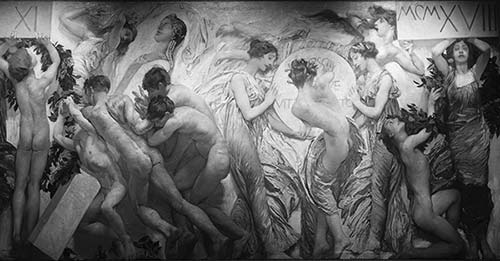
Cost and Hours: €5, more during special exhibits, includes audioguide, free first Sun of the month; open Tue-Sun 9:30-19:30, Thu until 22:30, closed Mon, last entry one hour before closing; across from La Scala Opera House at Piazza della Scala 6, toll-free tel. 800-167-619, www.gallerieditalia.com.
Visiting the Museum: Enter through the bank building facing Piazza della Scala and take the red-velvet stairs to the basement to pick up an audioguide (also downstairs is a bag check, WCs, and the original bank vault, which now stores racks and racks of paintings not on display).
Back upstairs, head into the main atrium of the bank, and consider the special exhibits displayed there. Then, to tackle the permanent art collection in chronological order, head to the far end of the complex and work your way back (follow signs for Palazzo Anguissola Antona Traversi and Palazzo Brentani). You’ll go through the café back into the Neoclassical palaces, where you’ll trace the one-way route through the “Da Canova a Boccioni” exhibit, including marble reliefs by the Neoclassical sculptor Antonio Canova and Romantic paintings by Francesco Hayez. Upstairs, you’ll see dramatic and thrilling scenes from the unification of Italy, as well as beautiful landscapes and cityscapes, especially of Milan. (An entire room is devoted to depictions of the now-trendy Naviglio Grande canal area in its workaday prime.)
On your way back to the bank building and the rest of the exhibit, take a moment to poke around the courtyard to find the officina di restituzioni alle gallerie—a lab where you can watch art restorers at work. Rejoining the permanent exhibit, you’ll see paintings from the late 19th and early 20th centuries: Romantic landscapes; hyperrealistic, time-travel scenes of folk life; and Impressionism. Finally, you’ll catch up to the art of the late 20th century, tucked between old bank-teller windows.
These sights are listed roughly in the order you’ll reach them as you travel west from Piazza del Duomo. The first one is just a few short blocks from the cathedral, while the last is just over a mile away.
This oldest museum in Milan was inaugurated in 1618 to house Cardinal Federico Borromeo’s painting collection. It began as a teaching academy, which explains its many replicas of famous works of art. Highlights include original paintings by Botticelli, Caravaggio, and Titian—and, most important, a huge-scale sketch by Raphael and a rare oil painting by Leonardo da Vinci.
Cost and Hours: €15, Pinacoteca open Tue-Sun 10:00-18:00, closed Mon; Biblioteca open Mon-Fri 9:00-17:00, closed Sat-Sun; last entry one hour before closing, audioguide-€3, near Piazza del Duomo at Piazza Pio XI 2, Metro: Duomo or Cordusio, tel. 02-806-921, www.ambrosiana.eu.
Visiting the Museum: Pick up the English-language map locating the rooms and major works I highlight below, and rent the audioguide (covers both permanent and special exhibits). Then head upstairs to begin your visit.
Raphael’s Cartoon (Room 5): Filling an entire wall, this drawing served as an outline for Raphael’s famous School of Athens fresco at the Vatican Museums. (A cartoon—cartone in Italian—is a full-size sketch that’s used to transfer a design to another surface.) First, watch the five-minute video introduction. While the Vatican’s much-adored fresco is attributed entirely to Raphael, it was painted mostly by his students. But this cartone was wholly sketched by the hand of Raphael. To transfer the fresco design to the wall, his assistants riddled this cartoon with pinpricks along the outlines of the figures, stuck it to the wall of the pope’s study, and then applied a colored powder. (Where the master cared more about the detail, you’ll see more pinpricks.) When they removed the cartone, the figures’ shapes were marked on the wall, and completing the fresco was a lot like filling in a coloring book.
Jan Brueghel (Room 7): As Cardinal Borromeo was a friend of Jan Brueghel, this entire room is filled with delightful works by the artist and other Flemish masters. Study the wonderful detail in Brueghel’s Allegory of Fire and Allegory of Water. The Flemish paintings are extremely detailed—many are painted on copper to heighten the effect—and offer an insight into the psyche of the age. If the cardinal were asked why he enjoyed paintings that celebrated the secular life, he’d likely say, “Secular themes are God’s book of nature.”
Leonardo Hall (Room 24): During his productive Milan years, Leonardo painted (oil on wood) Portrait of a Musician—as delicate, mysterious, and thought-provoking as the Mona Lisa. (This is the only one of his paintings that remains in Milan.) The large fresco filling the far wall—with Christ receiving the crown of thorns—is by Bernardino Luini, one of Leonardo’s disciples. But I find the big replica painting of The Last Supper most interesting. When the cardinal realized that Leonardo’s marvelous frescoed original was fading, he commissioned Andrea Bianchi to paint on canvas a careful copy to be displayed here for posterity. Today, this copy gives a rare chance to appreciate the original colorful richness of the now-faded masterpiece.
Biblioteca Ambrosiana: The 17th-century library hosts a revolving display of Leonardo sketches and notes. These are from the precious Codex Atlanticus, with more than a thousand busy pages done by Leonardo for his own reference, giving us a peek into his amazing mind. On any given day 16 pages are on display with English descriptions.
This square and monument mark the center of Milan’s financial district. The bold fascist buildings in the neighborhood were built in the 1930s under Mussolini. Italy’s major stock exchange, the Borsa, faces the square. Stand in the center and appreciate the contemporary take on ancient aesthetics (you’re standing atop the city’s ancient Roman theater). Find the stern statues representing various labors and occupations and celebrating the nobility of workers—typical whistle-while-you-work fascist themes.
Now notice the equally bold modern statue in the center. After a 2009 contest to find the most appropriate sculpture to grace the financial district, this was the winner. With Italy’s continuing financial problems, here we see how “the 99 percent” feel when they stand before symbols of corporate power. (Notice how the finger is oriented—it’s the 1 percent, and not the 99 percent, who’s flipping the bird.) The 36-foot-tall Carrara marble digit was made by Maurizio Cattelan, the most famous—or, at least, most controversial—Italian sculptor of our age. L.O.V.E., as the statue is titled, was temporary at first. But locals liked it, and, by popular demand, it’s now permanent.
This church, part of a ninth-century convent built into a surviving bit of Milan’s ancient Roman wall, dates from around 1500. Despite its simple facade, it’s a hit with art lovers for its amazing cycle of Bernardino Luini frescoes. Stepping into this church is like stepping into the Sistine Chapel of Lombardy.
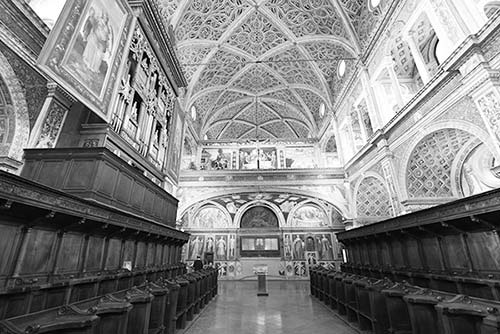
Cost and Hours: Free; Tue-Sun 9:30-19:30, closed Mon; Corso Magenta 15 at the Monastero Maggiore, Metro: Cadorna or Cairoli, tel. 02-8844-5208.
Visiting the Church: Bernardino Luini (1480-1532), a follower of Leonardo, was also inspired by his contemporaries Michelangelo and Raphael. Sit in a pew and take in the art, which has the movement and force of Michelangelo and the grace and calm beauty of Leonardo.
Maurizio, the patron saint of this church, was a third-century Roman soldier who persecuted Christians, then converted, and eventually worked to stop those same persecutions. He’s the guy standing on the pedestal in the upper right, wearing a bright yellow cape. The nobleman who paid for the art is to the left of the altar, kneeling and cloaked in black and white. His daughter, who joined the convent here and was treated as a queen (as nuns with noble connections were), is to the right. And all around are martyrs—identified by their palm fronds.
The adjacent Hall of Nuns (Aula delle Monache), a walled-off area behind the altar, is where cloistered sisters could worship apart from the general congregation. Fine Luini frescoes appear above and around the wooden crucifix. The Annunciation scene at the corners of the arch features a cute Baby Jesus zooming down from heaven (see Mary, on the right, ready to catch him). The organ dates from 1554, and the venue, with its fine acoustics, is popular for concerts with period instruments. Explore the pictorial Bible that lines the walls behind the wooden seats of the choir. Luini’s landscapes were groundbreaking in the 16th century. Leonardo incorporated landscapes into his paintings, but Luini was among the first to make landscape the main subject of the painting.
Nearby: You’ll exit the Hall of Nuns into the lobby of the adjacent Archaeological Museum, where you can pay €5 to see part of the ancient city wall and a third-century Roman tower.
One of Milan’s top religious, artistic, and historic sights, this church was first built on top of an early Christian martyr’s cemetery by St. Ambrose around AD 380, when Milan had become the capital of the fading (and Christian) western Roman Empire.
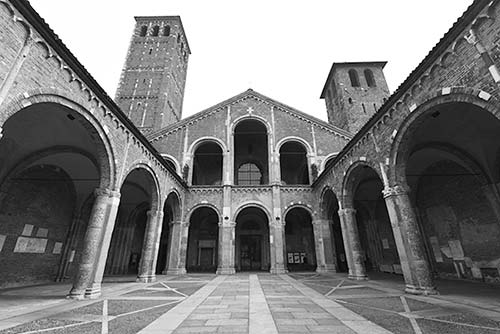
Cost and Hours: Free, Mon-Sat 10:00-12:30 & 14:30-18:00, Sun 15:00-17:00, modest attire required, Piazza Sant’Ambrogio 15, Metro: Sant’Ambrogio, tel. 02-8645-0895, www.basilicasantambrogio.it.
Visiting the Church: Ambrose was a local bishop and one of the great fathers of the early Church. Besides his writings, he’s remembered for converting and baptizing St. Augustine of Hippo, who himself became another great Church father. The original fourth-century church was later (in the 12th century) rebuilt in the Romanesque style you see today.
As you step “inside” from the street, you emerge into an arcaded atrium—standard in many churches back when people weren’t allowed to actually enter the church until they were baptized. The unbaptized waited here during Mass. The courtyard is textbook Romanesque, with playful capitals engraved with fanciful animals. Inset into the wall (right side, above the pagan sarcophagi) are stone markers of Christian tombs—a reminder that this church, like St. Peter’s at the Vatican, is built upon an ancient Roman cemetery.
From the atrium, marvel at the elegant 12th-century facade, or west portal. It’s typical Lombard medieval style. The local bishop would bless crowds from its upper loggia. As two different monastic communities shared the church and were divided in their theology, there were also two different bell towers.
Step into the nave and grab a pew. The mosaic in the apse features Christ Pantocrator (“All Powerful”) in the company of Milanese saints. Around you are pillars with Romanesque capitals and surviving fragments of the 12th-century frescoes that once covered the church.
The 12th-century pulpit sits atop a Christian sarcophagus dating from the year 400. Study its late Roman and early Christian iconography—on the side facing the altar, Apollo on his chariot morphs into Jesus on a chariot. You can see the moment when Jesus gave the Old Testament (the first five books, anyway) to his apostles.
The precious, ninth-century golden altar has four ancient porphyry columns under an elegant Romanesque 12th-century canopy. The entire ensemble was taken to the Vatican during World War II to avoid destruction. That was smart—the apse took a direct hit in 1943. A 13th-century mosaic was destroyed; today we see a reconstruction.
Step into the crypt, under the altar, to see the skeletal bodies of three people: Ambrose (in the middle, highest) and two earlier Christian martyrs whose tombs he visited before building the church.
Nearby: For a little bonus after visiting the church, consider this: The Benedictine monastery next to the church is now Cattolica University. With its stately colonnaded courtyards designed by Renaissance architect Donato Bramante, it’s a nice place to study. It’s fun to poke around and imagine being a student here.
The spirit of Leonardo lives here (a 10-minute walk from his Last Supper). Most tourists focus on the hall of Leonardo—the core of the museum—where wooden models illustrate his designs. But the rest of this immense collection of industrial cleverness is fascinating in its own right. There are exhibits on space exploration, mining, and radio and television (with some original Marconi radios); old musical instruments, computers, and telephones; chunks of the first transatlantic cable; and interactive science workshops. Out back are several more buildings containing antique locomotives and a 150-foot-long submarine from 1957. Ask for an English museum map from the ticket desk—you’ll need it. On weekends, this museum is very popular with families, so come early or be prepared to wait in line.
Cost and Hours: €10; Tue-Fri 10:00-18:00, Sat-Sun until 19:00, shorter hours off-season, closed Mon year-round; Via San Vittore 21, Metro: Sant’Ambrogio; tel. 02-485-551, www.museoscienza.org.
Decorating the former dining hall (cenacolo) of the Church of Santa Maria delle Grazie, this remarkable, exactingly crafted fresco is one of the ultimate masterpieces of the Renaissance. Reservations are mandatory and should be booked long in advance.
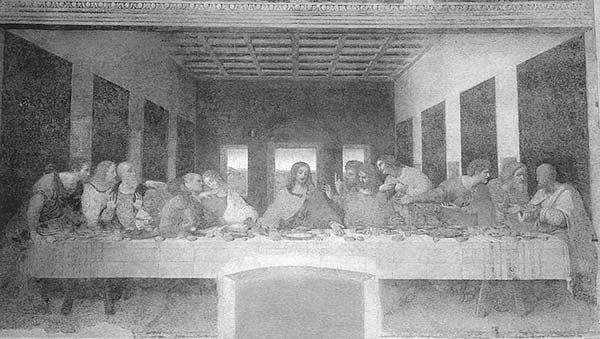
Cost and Hours: €15 (includes €2 reservation fee), four time slots include a tour and cost an extra €3.50 (9:30 and 15:30 in English; 10:00 and 16:00 in Italian); open Tue-Sun 8:15-18:45 (last entry), closed Mon, arrive 20 minutes before your timed entry; Piazza Santa Maria delle Grazie 2; tel. 02-9280-0360, http://cenacolovinciano.org.
Reservations: Mandatory timed-entry reservations can be made by phone or online—but they can sell out in minutes. Tickets for each calendar month go on sale about three months ahead; for example, bookings for July open in April. Check the website to find out when tickets for your dates will be released. For peak season tickets, be ready to book the moment they’re released (Milan time).
To book online, go to http://cenacolovinciano.vivaticket.it (you’ll have to create an account to book tickets). A calendar shows available time slots for the coming months. If your time slot includes a tour, you must add the €3.50 tour supplement when you check out (you won’t be able to buy a ticket without it).
If you book by phone, you’ll have more days and time slots to choose from (no same-day tickets, tel. 02-9280-0360, from the US dial 011-39-02-9280-0360, office open Mon-Sat 8:00-18:30, closed Sun; the number is often busy--once you get through, select 2 for an English-speaking operator).
Tour Option: If you can’t get a reservation, you can book a pricier (€65-80) walking or bus tour that includes a guided visit to The Last Supper. Reserve at least a week ahead (see here).
Last-Minute Tickets: A few same-day spots may be available due to cancellations. You can try showing up and asking at the desk--even if the sold out sign is posted (ideally when the office opens at 8:00, more likely on weekdays).
Getting There: The Church of Santa Maria delle Grazie is a seven-minute walk from Metro: Conciliazione. From the track, follow signs for Cenacolo. You’ll walk four blocks. After the first bend you’ll see the fine red-brick facade of the church ahead. Or take tram #16 from the Duomo (direction: San Siro or Piazzale Segesta), which drops you off in front of the church. When leaving, cross the street to catch the tram back to the Duomo.
Getting In: Stow your bag (free, required), pick up your ticket, and consider renting the audioguide. Your time will be called 15 minutes before, and you’ll enter the waiting room. Use this time to study up. At your appointed time, the doors open and your group enters. No stress, no crowds, beautifully organized...it’s a peaceful and inspiring experience. There’s a fine WC at the exit.
Audioguide: The fine €3.50 audioguide (standard jack) is very helpful. Its spiel fills every second of the time you’re in the room—a short intro (#100) and then tracks 1 through 5—for the entire 15 minutes you’re inside. You can start listening to it in the waiting room while studying the reproduction of The Last Supper.
Background: Milan’s leading family, the Sforzas, hired Leonardo to decorate the dining hall of the Dominican monastery that adjoins the church (the Dominican order traditionally placed a Last Supper on one end of their refectories, and a Crucifixion at the other). Leonardo worked on the project from about 1494 until 1498. This gift was essentially a bribe to the monks so that the Sforzas could place their family tomb in the church. Ultimately, the French drove the Sforzas out of Milan, they were never buried here, and the Dominicans got a great fresco for nothing.
Deterioration began within six years of The Last Supper’s completion because Leonardo painted on the wall in layers, as he would on a canvas, instead of applying pigment to wet plaster in the usual fresco technique. (Examining the extremely close-up photos in the waiting room lets you see how the paint is simply flaking off.) The church was bombed in World War II, but—miraculously, it seems—the wall holding The Last Supper remained standing. A 21-year restoration project (completed in 1999) peeled away 500 years of touch-ups, leaving Leonardo’s masterpiece faint but vibrant.
Visiting The Last Supper: To minimize damage from humidity, only 30 tourists are allowed in every 15 minutes for exactly 15 minutes. While you wait, read the history of the masterpiece or listen to the audioguide. As your appointed time nears, you’ll be herded between several rooms to dehumidify, while doors close behind you and open up slowly in front of you.
And then the last door opens, you take a step, you look right, and...there it is. In a big, vacant, whitewashed room, you’ll see faded pastels and not a crisp edge. The feet under the table look like negatives. But the composition is dreamy—Leonardo captures the psychological drama as the Lord says, “One of you will betray me,” and the apostles huddle in stressed-out groups of three, wondering, “Lord, is it I?” Some are scandalized. Others want more information. Simon (on the far right) gestures as if to ask a question that has no answer. In this agitated atmosphere, only Judas (fourth from left and the only one with his face in shadow)—clutching his 30 pieces of silver and looking pretty guilty—is not shocked.
The circle meant life and harmony to Leonardo. Deep into a study of how life emanates in circles—like ripples on a pool hit by a pebble—Leonardo positioned the 13 characters in a semicircle. Jesus is in the center, from whence the spiritual force of God emanates, or ripples out.
The room depicted in the painting seems like an architectural extension of the monk’s dining hall. The disciples form an apse, with Jesus as the altar—in keeping with the Eucharist. Jesus anticipates his sacrifice, his face sad, all-knowing, and accepting. His feet even foreshadow his death by crucifixion. Had the door, which was cut out in 1652, not been added, you’d see how Leonardo placed Jesus’ feet atop each other, ready for the nail.
The perspective is mathematically correct, with Jesus’ head as the vanishing point where the converging sight lines meet. In fact, restorers found a tiny nail hole in Jesus’ left eye, which anchored the strings Leonardo used to establish these lines. The table is cheated out to show the meal. Notice the exquisite lighting. The walls are lined with tapestries (as they would have been), and the one on the right is brighter in order to fit the actual lighting in the refectory (which has windows on the left). With the extremely natural effect of the light and the drama of the faces, Leonardo created a masterpiece.
The monks ate at three tables just like the one Leonardo painted, with a carefully ironed tablecloth also just like the one painted. The monks ate in silence, communicating with hand gestures (notice the ballet of hand gestures in Leonardo’s composition).
Save a minute or two for the fresco of the Crucifixion on the opposite wall, which provides an instructive contrast. This is done in the traditional fresco technique—less soul and subtlety but much better preserved. It needed to be done quickly (as the plaster dried) and was finished in three months (compared to over three years for The Last Supper). For a good look at the contrasting styles, find the faded image of the Sforza duchess in the lower right corner. She was added to the scene by Leonardo using the same technique he used in The Last Supper.
Before stepping out, from the back of the room look one last time at Leonardo’s masterpiece and imagine this room filled with three more tables and 60 monks immersed in devotion and with no idea that 500 years later travelers would be dropping by to appreciate the art decorating their hall.
The adjacent Church of Santa Maria delle Grazie survived World War II unscathed and is worth a quick look (free). Its fine Gothic arches lead to a Renaissance Bramante-designed dome. The Dominican monks frescoed in black and white on each pilaster were the first monks to eat under Leonardo’s Last Supper.
Milan’s top collection of Italian paintings (13th-20th century) is world class, but it can’t top those in Rome or Florence. Established in 1809 to house Napoleon’s looted art, it fills the first floor above a prestigious art college. You’ll dodge scruffy starving artists...and wonder if there’s a 21st-century Leonardo in your midst.
Cost and Hours: €12, free first Sun of month; Tue-Sun 8:30-19:15, closed Mon, last entry 45 minutes before closing; audio-guide–€5 (useful, ID required, but museum has excellent English descriptions), free lockers, Via Brera 28, Metro: Lanza or Montenapoleone, tel. 02-722-631, www.pinacotecabrera.org.
Visiting the Museum: Enter the grand courtyard of a former monastery, where you’ll be greeted by the nude Napoleon with Tinkerbell (by Antonio Canova). Climb the stairway (following signs to Pinacoteca), buy your ticket, and pick up an English map of the museum’s masterpieces, some of which I’ve highlighted below. You’ll follow a clockwise, chronological route through the huge collection. Take time to read the English descriptions, many of which are absolutely poetic. And, to get the most out of your visit, invest in the audioguide. Here are the highlights:
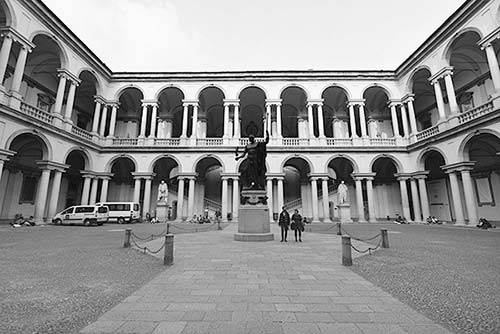
Next to the information desk peek through the window to see the 300-year-old library, then pop into the chapel (on the left) frescoed by a follower of Giotto in the 1300s. After the turnstile, enjoy the setup in the short entry hall.
Before Antonio Canova’s big marble statue of naked Napoleon, head left into the dark, narrow blue hall to see Andrea Mantegna’s iconic foreshortened Christ (and others by the influential early Renaissance master). Room 8 features more Mantegna, and bright and vivid paintings by the Bellini brothers from around 1500. Room 9 is for the big canvases by 16th-century Venetian masters (like Tintoretto and Paolo Veronese).
Past the towering marble statue of Napoleon, Room 15 holds four paintings by Vincenzo Campi, offering slices of local Milan life from 1591.
Then you reach the restoration lab, which offers a chance to peek in on the hard work of keeping these paintings looking so good.
Room 22 sparkles with High Gothic art. Carlo Crivelli, a contemporary of Leonardo, employed Renaissance technique while clinging to the mystique of the Gothic Age (that’s why I like him so much). And Gentile da Fabriano hints at the realism of the coming Renaissance (check out the lifelike flowers and realistic, bright gold paint—he used real gold powder).
Room 26 is nicknamed “The Golden Room” for its Renaissance masterpieces from the early 16th century by Raphael (The Marriage of the Virgin), Piero della Francesca (Madonna and Child with Saints), and Donato Bramante.
In Room 28 don’t miss gritty-yet-intimate realism of Caravaggio’s Supper at Emmaus. Room 31 features Rubens (and other Dutch and Flemish works). And Room 35 is dedicated to “postcard” art from the 18th-century Grand Tour days (like Venice-scapes by Canaletto and Francesco Guardi).
Finally, in Room 37 you come to 19th-century Romanticism, and in Room 38 three patriotic paintings, including The Kiss by Francesco Hayez, which evoke the spirit of Italy’s fight for independence, the Risorgimento.
With a quick swing through this quiet one-floor museum, you’ll get an idea of the interesting story of Italy’s rocky road to unity: from Napoleon (1796) to the victory in Rome (1870). You’ll see paintings, uniforms, monuments, a city model, and other artifacts. Thoughtful English descriptions help make this a meaningful look at this important period of Italian history.
Cost and Hours: Free; Tue-Sun 9:00-13:00 & 14:00-17:30, closed Mon; just around the block from Brera Art Gallery at Via Borgonuovo 23, Metro: Montenapoleone, tel. 02-8846-4176, www.museodelrisorgimento.mi.it.
This classy house of art features Italian paintings of the 15th through 18th century, old weaponry, and lots of interesting decorative arts, such as a roomful of old sundials and compasses. It’s all on view in a sumptuous 19th-century residence.
Cost and Hours: €10; Wed-Mon 10:00-18:00, closed Tue; audioguide-€1, Via Manzoni 12, Metro: Montenapoleone, tel. 02-794-889, www.museopoldipezzoli.it.
This unique 19th-century collection of Italian Renaissance furnishings was assembled by two aristocratic brothers who spent a wad turning their home into a Renaissance mansion.
Cost and Hours: €9, includes audioguide, €6 on Wed; Tue-Sun 13:00-17:45, closed Mon; Via Gesù 5, Metro: Montenapoleone, tel. 02-7600-6132, www.museobagattivalsecchi.org.
The castle of Milan tells the story of the city in brick. Today it features a vast courtyard, a sprawling museum, and—most importantly—a chance to see Michelangelo’s final, unfinished pietà.
Cost and Hours: €10; museum open Tue-Sun 9:00-17:30, closed Mon; castle grounds open daily 7:00-19:30; WCs and free/mandatory lockers downstairs from ticket counter, Metro: Cairoli or Lanza, tel. 02-8846-3700, www.milanocastello.it.
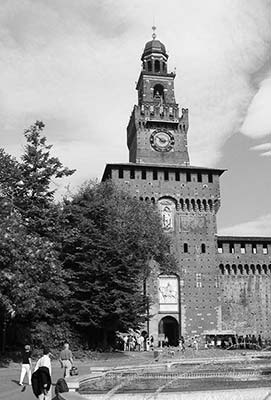
Background: Built in the late 1300s as a military fortress, Sforza Castle guarded the gate to the city wall and defended Milan from enemies “within and without.” It was beefed up by the Sforza duke in 1450 in anticipation of a Venetian attack. Later, the Sforza family made it their residence, building their Renaissance palace into the fortress. It was even home to their in-house genius, Leonardo. (When he applied for a position with the Sforza family, he did so as a military engineer and contributed to the design of the ramparts.) During the time of foreign rule (16th-19th century), it was a barracks for occupying Spanish, French, and Austrian soldiers. Today it houses an array of museums, but I’d concentrate on the Michelangelo pietà and the Museum of Ancient Art.
 Self-Guided Tour: This tour begins outside the fortress, then focuses on the highlights inside.
Self-Guided Tour: This tour begins outside the fortress, then focuses on the highlights inside.
The Fortress: The gate facing the city center stands above a ditch that was once filled with water. A relief celebrates Umberto I, the second king of Italy. Above that, a statue of St. Ambrose, the patron of Milan (and a local bishop in the fourth century), oversees the action. Notice the diagram a few steps away that shows how the city was encircled first by a crude medieval wall, and then by a state-of-the-art 16th-century wall—of which this castle was a key element. It’s apparent from the enormity of these walls that Milan was a strategic prize. Today, the walls are gone, giving the city two circular boulevards.
This immense brick fortress—exhausting at first sight—can only be described as heavy. Its three huge courtyards originally functioned as military parade grounds, but today host concerts and welcome the public. (The holes in the walls were for scaffolding.)
• As you enter the main courtyard, look to your left to see the restored hospital building that houses the...
Museo Pietà Rondanini (Michelangelo): This is a rare opportunity to enjoy a Michelangelo statue with no crowds. Michelangelo died while still working on this piece, his fourth pietà—a representation of a dead Christ with a sorrowful Virgin Mary. While unfinished and seemingly a mishmash of corrections and reworks, it’s a thought-provoking work by a genius at nearly 90 years of age, who knows he’s fast approaching the end of his life. The symbolism is of life and of death: Jesus returning to his mother, as two bodies seem to become one.
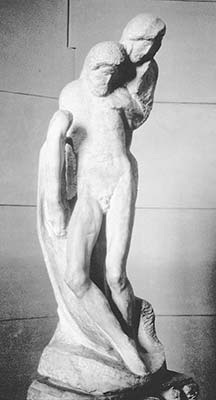
Michelangelo’s more famous pietà at the Vatican (carved when he was in his 20s) features a beautiful, young, and astonished Mary. Here, Mary is older and wiser. Perhaps Mary is now better able to accept death as part of life...as is Michelangelo. The pietà at the Vatican is simple and clear, showing two different people: the mother holding her dead son. Contemplating the Pietà Rondanini, you wonder who’s supporting whom. It’s confused and complex, each figure seeming to both need and support the other.
This unfinished statue shows the genius of Michelangelo midway through a major rework—Christ’s head is cut out of Mary’s right shoulder, and an earlier arm is still just hanging there. Above Mary’s right ear, you can see the remains of a previous face (eye, brow, and hairline).
And there’s a certain power to this rawness. Walk around the back to see the strain in Mary’s back (and Michelangelo’s rough chisel work) as she struggles to support her son. The sculpture’s elongated form hints at the Mannerist style that would follow.
Facing the pietà is a bronze life-size head, based on a death mask made at the artist’s passing in 1564. Imagine him working on his pietà—still vibrant and seeking.
• From the pietà, return to the big courtyard and head for the little drawbridge (on the left, directly across from where you entered the complex). Pass through to find (on the right) the entrance to the...
Museum of Ancient Art (Museo d’Arte Antica): This sprawling collection fills the old Sforza family palace with interesting medieval armor, furniture, early Lombard art, and much more.
In the first room, among ancient sarcophagi (with early Christian themes), stands a fine 14th-century equestrian statue—a memorial to Bernabò Visconti. Of the four virtues, he selected only two (strength and justice) to stand beside his anatomically correct horse, opting out of love and patience.
Farther along, the room of tapestries is dominated by a big embroidery of St. Ambrose defeating the heretical Arians. While that was a fourth-century struggle, 12 centuries later, he was summoned back in spirit to deal with Protestants, in support of Archbishop Borromeo. With St. Peter’s Basilica behind him, a Borromeo—like Ambrose stands tall and strong as a Counter-Reformation leader in defense of the Roman Church. The room is lined with 16th-century Flemish tapestries, which were easy to pack up quickly as the nobility traveled. These were typical of those used to warm chilly stone palaces.
Next, you’ll come to the Sala delle Asse. The Visconti family, who grew rich making silk in the Lake Como region, had their ballroom painted by Leonardo and his followers. While plastered over for centuries, this room was restored around 1900. Not much sparkle survives, but you can appreciate the intricate canopy woven with branches and rope in complicated knots—the work of Leonardo himself, in 1498.
From here, you’ll pass through rooms filled with weapons and armor from the 16th and 17th centuries.
• At this point, you’re free to go. But if you have a larger-than-average attention span, follow signs upstairs to the Decorative Arts Museum, then the Painting Gallery (Pinacoteca), and finally the Musical Instruments Museum. When you’re done, consider popping out the back door of the fortress and taking a break in the lush Sempione Park.
This is Milan’s equivalent of Central Park. With its circa-1900 English-style gardens, free Liberty Style aquarium, views of the triumphal arch, and sprawling family-friendly grounds, this park is particularly popular on weekends.
A 15-minute walk through the park, on the left, is the erector-set Branca Tower (Torre Branca), built for an exposition in the 1930s. For an inexpensive, commanding city view, you can ride an elevator as high as the Mary that crowns the Duomo (best in daylight, erratic hours—call or confirm at TI before making a special trip, Metro: Cadorna, www.museobranca.it, tel. 02-331-4120).
Next to the tower is the excellent Triennale di Milano, a design museum with changing exhibits that celebrate one of this city’s fortes (www.triennale.org).
At the far end of the park is the monumental Arco della Pace. Originally an arch of triumph, it comes with Nike, goddess of victory, commanding a six-horse chariot. It was built facing Paris to welcome Napoleon’s rule and to celebrate the ideals of the French Revolution, destined to lift Italy into the modern age. When the locals learned Napoleon was just another megalomaniac, they turned the horses around, their tails facing France.
This grand pedestrian boulevard and popular shopping street leads from Sforza Castle toward the town center and the Duomo. Via Dante was carved out of a medieval tangle of streets to celebrate Italian unification (c. 1870) and make Milan a worthy metropolis. Consequently, all the facades lining it are relatively new. Enjoy strolling this beautiful people zone, where you’ll hear the whir of bikes and the lilting melodies of accordion players instead of traffic noise. Photo exhibits are frequently displayed up and down the street. In front of Sforza Castle, a commanding statue of Giuseppe Garibaldi, a hero of the unification movement, looks down one of Europe’s longest pedestrian zones. From here you can walk to the Duomo and beyond (about 1.5 miles), appreciating Italian design both in shop windows and on smartly clothed Milanese.
Milan is famous for design, including architecture and urban planning. The big news in the last decade is a sparkling forest of glassy office and condominium towers around a parklike, pedestrian-only urban-renewal district called Porta Nuova. Civic leaders have reenvisioned this once-run-down neighborhood, neglected since its WWII bombing, effectively decentralizing the city that historically has been so Duomo-centric. An hour spent wandering this happy land of sleek and successful urban Italy does more to expand your understanding of Milan (and Italy) than any other hour you could spend in the city.
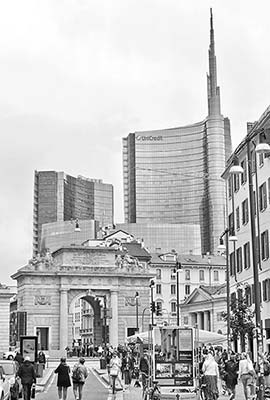
Visiting Porta Nuova: For help orienting yourself in this district, see the “Greater Milan” map on here.
Ride the Metro to Garibaldi FS and exit following Corso Como signs. Rocketing skyward before you in a group of contemporary office towers is the tallest structure in Italy, the UniCredit Building (750 feet high). Follow the curved road to reach the complex upon which that building sits. As you approach some escalators, you’ll see maps and signposts to keep you oriented. Head upstairs to the main square called...
Piazza Gae Aulenti: Enjoy the lively public hub with its delightful pond that transforms from shallow reflecting pool to dancing fountains throughout the day. In the center you’ll see glass “horns,” visually echoed in a nearby corridor by brass horns that allow people to gossip from one level to the next—a reminder that piazzas have always enabled people to connect with one another.
Many locals refer to this area simply as “Garibaldi.” Essentially an outdoor mall (with multinationals renting space), it’s a fun place to search for views of the Alps or to sate your hunger in the fancy downstairs food court.
The Vertical Forest: Continue your stroll beyond the piazza toward the wooden IBM building. On your left in the Isola (Island) neighborhood, you’ll see two condominium towers bushy with trees (800 of them plus about 20,000 other plants) called The Vertical Forest. Named the best building in Europe a couple years ago (designed by the Italian architect Stefano Boeri), these twin towers take “green” to a new level. The trees absorb the pollution created by its residents and contribute to a cooler atmosphere.

“Growing” from its base is the adjacent park called the Library of Trees. Laid out in a network of geometric patterns and paths, it serves as pedestrian zone, play area, and event venue. People can commune with each other and the more than 135,000 plants and trees living in this field of greens. Energy-consumption reduction, sustainability, workability, livability, and innovation are essentials of the Porta Nuova project.
Diamond Tower: Across the pedestrian bridge called the Passerella Gioia is the Varesine district. A cluster of jagged, balconied towers mix condominium residences with ground-floor shops and eateries. Beyond, an urban park is flanked by shorter condos and a series of commercial buildings nicknamed Diamantini (Little Diamonds), a nod to the massive, laminated glass Diamond Tower high-rise at the end of the development. Affectionately called Il Diamantone (The Big Diamond) for its irregular angles, the 31-story tower earned Gold LEED (Leadership in Environment Energy and Design) certification.
Stand in the middle of Passerella Gioia and take a 360-degree survey of this vibrant, sparkling, of-the-future neighborhood. Marvel at how this people-, business-, and environmentally friendly project has become not only an icon of the rebirth and revitalization of Milan but also a model for other cities looking ahead to smartly designed, forward-thinking urban development.
Corso Como and Porta Garibaldi: Back at the main square, Piazza Gae Aulenti, depart via the golden gossip horns down Via V. Capelli. Turn left on Corso Como and head to the medieval gate called Porta Garibaldi, once part of the city walls. Corso Como, while an old street, is a trendy high-end pedestrian mall popular for its aperitivo and cocktail bars and stylish shops. At #10 is 10 Corso Como, worth a quick look for its trendy Milanese design ware.
Immediately left of Porta Garibaldi is Eataly. Eataly (also in Rome, Florence, and New York) has turned the former Teatro Smeraldo into a gourmet megastore. It’s overwhelming but oddly enchanting, with its overpriced Italian market goods and restaurants serving all the major food groups—pasta, meats, vegetables, chocolate, and, of course, gelato (daily 10:00-24:00, Piazza XXV Aprile 10, Metro: Moscova, tel. 02-4949-7301, www.eataly.net).
Beyond Porta Garibaldi stretches Corso Garibaldi, for more lively Milanese pedestrian and shopping action.
Milan, although far from any major lake or river, has a sizable port, literally called the “Big Canal.” Since 1170, boats have been able to sail from Milan to the Mediterranean via the Ticino River (which flows into the Po River on its way to the Adriatic Sea). Five hundred years ago, Leonardo helped design a modern lock system. During the booming Industrial Age in the 19th century—and especially with the flurry of construction after Italian unification—ships used the canals to bring in the marble and stone needed to make Milan the great city it is today. In fact, one canal (filled in during the 1930s) let barges unload stone right at the building site of the great cathedral. In the 1950s, landlocked Milan was the seventh-biggest port in Italy, as its canals aided in rebuilding the bombed-out city.
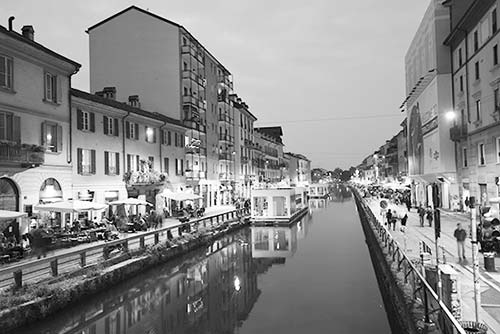
Today, disused train tracks parallel the canal, old warehouse buildings recall the area’s working-class heritage, and former workers’ tenements—once squalid and undesirable—are being renovated. The once-rough area now dubbed Milan’s “Little Venice” is trendy, traffic-free, and thriving with inviting bars and eateries. Come here for dinner or a late-afternoon drink (for recommendations, see “Eating in Milan,” later).
Getting There: Ride the Metro (or tram #2) to Porta Genova, exit following signs to Via Casale, and walk the length of Via Casale one block directly to the canal. Most bars and restaurants are to the left, on both sides of the canal. (See the map on here).
Europe’s most artistic and dreamy cemetery experience, this grand place was built just after unification to provide a suitable final resting spot for the city’s “famous and well-deserving men.” Any cemetery can be evocative, but this one—with its super-emotional portrayals of the deceased and their heavenly escorts (in art styles c. 1870-1930)—is in a class by itself. It’s a vast garden art gallery of proud busts and grim reapers, heartbroken angels and weeping widows, too-young soldiers and countless old smiles, frozen on yellowed black-and-white photos.
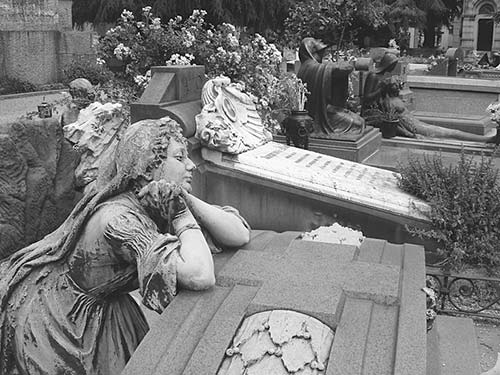
Cost and Hours: Free, Tue-Sun 8:00-18:00, closed Mon, pick up map at the entrance gate, ride Metro purple line 5 to Monumentale, tel. 02-8846-5600.
The largest equestrian monument in the world is a reconstruction of a model created in 1482 by Leonardo da Vinci for the Sforza family. The clay prototype was destroyed in 1499 by invading French forces, who used it for target practice. In 1982, American Renaissance-art collector Charles Dent decided to build the 15-ton, 24-foot-long statue from Leonardo’s design, planning to present it to the Italians in homage to Leonardo’s genius. Unfortunately, Dent died before the project could be completed. In 1997, American sculptor Nina Akamu created a new clay model that became the template for the final statue; it was unveiled in 1999.
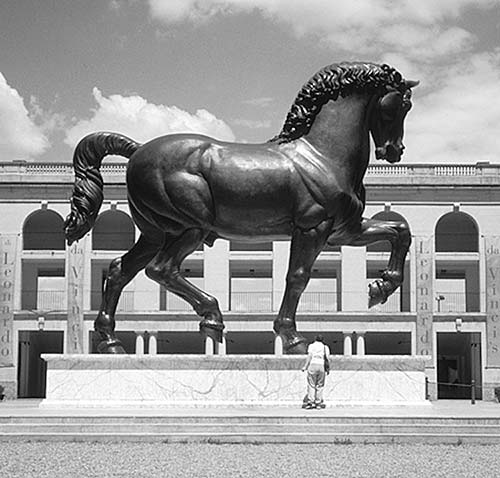
Getting There: The statue (free to view) is at a horse racetrack on the western outskirts of town—ride Metro purple line 5 to San Siro Ippodromo.
For locations, see the map on here.
For world-class window shopping, visit the Quadrilateral, an elegant high-fashion shopping area around Via Montenapoleone, northeast of La Scala Opera House. This was the original Beverly Hills of Milan. In the 1920s, the top fashion shops moved in, and today it remains the place for designer labels. Most shops close Sunday and for much of August. On Mondays, stores open only after 16:00. In this land where fur is still prized, the people-watching is as entertaining as the window shopping. Notice also the exclusive penthouse apartments with roof gardens high above the scene. Via Montenapoleone and the pedestrianized Via della Spiga are the best streets.
Whether you’re gawking or shopping, here’s the best route: From Piazza della Scala, walk up Via Alessandro Manzoni to the Metro stop at Montenapoleone, browse down Via Montenapoleone, and cut left on Via Santo Spirito (lined with grand aristocratic palazzos—peek into the courtyard at #7). Across the street, step into the elegant courtyard at #10 to check out the café sitters and their poodles. Continue to the end of Via Santo Spirito, then turn right to window shop down traffic-free Via della Spiga. After a few short blocks, turn right on Via Sant’Andrea and then left, back onto Montenapoleone, which leads you through a final gauntlet of temptations to Corso Giacomo Matteotti, near the Piazza San Babila. Then (for less-expensive shopping thrills), walk back to the Duomo down the pedestrian-only Corso Vittorio Emanuele II.
For a (slightly) more reasonably priced shopping excursion, step into La Rinascente—one of Europe’s classic department stores. (It’s around the left side as you face the front of the Duomo.) Simply riding the escalator up and up gives a fun overview of Italian design and marketing. The seventh floor is a top-end food circus with recommended restaurants, terrace views of the Duomo, and a public WC. The store’s name translates roughly as “the place reborn” and fits its history. In an earlier life, this was a fine Art Nouveau-style building—until it burned down in 1918. Rebuilt, it was bombed in World War II and rebuilt once again (Sun-Thu 9:30-21:00, Fri-Sat until 22:00, has a VAT refund office, faces north side of the Duomo on Piazza del Duomo).
Heading away from the Duomo, stroll between the arcades on the Corso Vittorio Emanuele II, surrounded by clothing stores and other tempting material pleasures. At Via Passarella, detour to the right to check out Excelsior, a bold high-end concept store. Moving walkways take you from level to colorful level with pulsing music and electronic art installations. If you’re looking for the perfect €1,000 shirt, you’ve come to the right place (daily 10:00-20:30, Galleria del Corso 4, two long blocks behind the Duomo, tel. 027-630-7301).
Double back to the Corso Vittorio Emanuele II to continue shopping all the way to the San Babila Metro station (and the ritzy Quadrilateral area described earlier).
For evening action, check out the artsy Brera area in the old center, with several swanky sidewalk cafés and lots of bars that stay open late. Home to the local art university, this district has a sophisticated, lively people-watching scene. For a younger scene, try the Naviglio Grande canal district, Milan’s formerly bohemian, now-gentrified “Little Venice” (Metro: Porta Genova or tram #2; for restaurant recommendations here, see “Eating in Milan,” later).
There are always concerts and live music in the city—check periodicals from the TI.
My recommended hotels are all within a few minutes’ walk of a Metro station. With Milan’s fine subway system, you can get anywhere in town in a flash.
Hotel prices in Milan rise and fall with the convention schedule. In March, April, September, and October, the city can be completely jammed by conventions, and hotel prices go sky-high (see www.fieramilano.it for convention schedule). My rankings are based on regular prices, not the much-higher convention rates.
Summer is usually wide open, with soft or discounted prices, though many hotels close in August for vacation. Hotels cater more to business travelers than to tourists, so prices and availability are a little better on Fridays and Saturdays.
There are only a few small, family-style hotels left in the center, and the good ones charge top dollar for their location. To save money, consider searching for a deal at a basic chain hotel (such as Ibis) near a Metro stop.
The Duomo area is thick with people-watching, reasonably priced eateries, and the major sightseeing attractions, but hotel prices are high.
$$$$ Hotel Spadari boasts an Art Deco-inspired lobby designed by the Milanese artist Giò Pomodoro (“Joe Tomato” in English). The 40 cool-blue rooms have billowing drapes, big paintings, and designer doors. It’s next to the recommended Peck Gourmet Deli, and two blocks from the Duomo (air-con, elevator, Via Spadari 11, tel. 02-7200-2371, www.spadarihotel.com, reservation@spadarihotel.com).
$$$$ Hotel Gran Duca di York, three blocks from the Duomo, is on a stark street of banks and public buildings. Set in a former priory-run school attended by the then-future Pope Pius X, it has comfy and spacious public areas, and the 33 rooms are modern and bright (air-con, elevator, Via Moneta 1, Metro: Cordusio or Duomo, tel. 02-874-863, www.ducadiyork.com, info@ducadiyork.com).
These slightly-less-central places are close to the Via Dante and Via Brera shopping and restaurant scenes.
$$$$ Antica Locanda dei Mercanti offers 15 rooms in an 18th-century palazzo an easy 10-minute walk from the Duomo. While each room has its own personality (some have kitchenettes, others have small terraces), all have a fresh-flower vibe that embraces old and new—a nice change for businesslike Milan (air-con, elevator, Via San Tomaso 6, reception on first floor, Metro: Cairoli or Cordusio, tel. 02-805-4080, www.locanda.it, locanda@locanda.it, Alex and Eri).
$$$$ Hotel Cusani prides itself on service and has 92 classy, classic, and bright rooms and ample space to lounge (air-con, elevator, family rooms, bar, pay parking; Via Cusani 13, Metro: Cairoli, tel. 028-5601, www.gruppouna.it, hotel.cusani@unahotels.it).
$$$ Hotel Star rents 30 rooms, most of which have been modernized and feature artsy, somewhat gaudy decor; interior rooms are quieter (air-con, elevator, Via dei Bossi 5, Metro: Cordusio, tel. 02-801-501, www.hotelstar.it, hotelstar@hotelstar.it, Vittoria).
These two hotels are farther from the action in a sleepy, mostly residential zone, but the prices are lower. For locations (about a 15-minute walk or quick tram or Metro ride west of the Duomo), see the map on here.
$$$ Antica Locanda Leonardo, just down the street from The Last Supper, has a romantic, Old World vibe, antique furnishings, and a spacious breakfast room. Each of its 17 uniquely decorated rooms faces either a courtyard (cheaper, some street noise) or a tranquil garden (some rooms with garden balcony, air-con, elevator, Corso Magenta 78, tel. 02-4801-4197, www.anticalocandaleonardo.com, info@anticalocandaleonardo.com). From the Duomo area, you can ride tram #16 or take the Metro to either Cadorna or Conciliazione and walk five minutes.
$$ B&B Hotel Milano Sant’Ambrogio, part of a chain of budget hotels, has 94 efficient, cookie-cutter rooms and a sizable fourth-floor terrace. Rooms come with some tram noise (request a quieter one) but are worth considering if you can get a deal (breakfast extra, air-con, elevator, Via degli Olivetani 4, Metro: S. Ambrogio, tel. 02-4810-1089, www.hotel-bb.com, mi.santambrogio@hotelbb.com). It’s on a side street near the Leonardo da Vinci Science Museum, about a five-minute walk from either The Last Supper or Basilica Sant’Ambrogio.
These places are a 10-minute walk east of the basilica. See the map on here for locations.
$$$ Hotel Ariston, with uniformed porters, offers 52 contemporary rooms that range from blah to fancy minimalist (some with views). It’s a solid option if charm is not a prerequisite (air-con, elevator, bar, Largo del Carrobbio 2, Metro: Duomo, tel. 02-7200-0556, www.aristonhotel.com, info@aristonhotel.com).
Hostel: ¢ Ostello Bello sits along a skinny lane and is brimming with youthful and young-at-heart travelers. It has quirky decor and is generous, considering its value price, with complimentary food, nearly nightly activities, and a welcome drink. The multiuse entry room is the reception, dining area, bar, lounge, and entertainment venue rolled into one. Their bigger (grande) location is by Milano Centrale train station (private rooms available, air-con, elevator, game room, terraces; Via Medici 4, Metro: Duomo or Missori, tel. 02-3658-2720, mobile 334-261-0356, www.ostellobello.com, booking@ostellobello.com).
The train station neighborhood is more practical than characteristic. Its hotels are utilitarian business-class places with prices that bounce all over depending upon the convention schedule; most of the year, many have rooms in the €100-125 range. You’ll find more shady characters than shady trees in the parks, and lots of ethnic restaurants and massage parlors as you head away from the immediate vicinity of the station. But it’s convenient to trains, the Metro, and airport shuttles, and if you hit it outside of convention times, the prices are hard to beat.
On Via Napo Torriani: This street, a five-minute walk from the station, is lined with midrange hotels (exit the station, head straight across the square, then veer left onto Via Napo Torriani). $$ Hotel Berna feels like a classic European hotel, with an old-school lobby, uniformed bellhops, and 116 faded rooms with some nice upgrades (air-con, elevator, Via Napo Torriani 18, tel. 02-677-311, www.hotelberna.com). $$ Hotel Garda is cheaper and less welcoming, with 55 rooms (RS%—email first to get a promo code, then book on their website; breakfast extra, air-con, elevator, Via Napo Torriani 21, tel. 02-6698-2576, www.hotelgardamilan.com, info@hotelgardamilan.com).
Closest to Station: These options are in the same block of buildings just in front and to the left of the station.
$$ Hotel Aosta is IKEA-esque, practical, tidy, and convenient, with a gentle and helpful staff. Some of the 63 business-class rooms have views onto the piazza, as does the breakfast room (air-con, elevator, Piazza Duca d’Aosta 16, tel. 02-669-1951, www.hotelaostamilano.it, aosta@minihotel.it).
Hostel: ¢ Ostello Bello Grande has converted what was a business-class hotel into a hostel with hipster flair. Worth considering even if you’re not a hosteler, it comes with an inviting rooftop terrace and a shared kitchen (private rooms available, includes breakfast and aperitivo happy-hour snacks, air-con, elevator, laundry, Via Lepetit 33, tel. 02-670-5921, www.ostellobello.com, booking.lepetit@ostellobello.com). With the tracks to your back, leave the station to the left, cross the taxi stand, and then cross the road. The hostel is around the corner from Ristorante Giglio Rosso.
$$$$ Sheraton Milan Malpensa Airport Hotel is adjacent to Terminal 1—from the lobby, it’s just a five-minute walk to airport security (tel. 02-23351, www.marriott.com [URL inactive]). Or try $ Best Western Cavalieri della Corona, with big clean rooms and a good restaurant (airport shuttle–€3, 2/hour; tel. 0331-730-350, www.cavalieridellacorona.com).
Milan’s hundreds of trendy bars, delis, rosticcerie, and self-service cafeterias cater to people with plenty of taste and more money than time. You’ll find delightful eateries all over town.
Milan’s signature dishes are risotto alla Milanese and ossobuco. The risotto is flavored with saffron, which gives it an intense yellow color. The subtle flavor of the saffron pairs nicely with the veal shanks of ossobuco (meaning “marrow” or, literally, “hole in the bone” shank). The prized marrow, extracted with special little forks, is considered the best part of the meal. Also popular is the cotoletta alla Milanese, a thin, breaded veal cutlet fried in clarified butter. Some places have supersized it and call it orecchio di elefante, an “elephant’s ear” (large enough to share).
Many locals like to precede dinner with an aperitivo—a buffet of finger foods offered free with a drink during happy hour. (While Campari made its debut in Milan, a simple glass of vino bianco or prosecco, the Italian champagne, is just as popular.) At about 18:00, bars fill their counters with inviting baskets of munchies, served free with these drinks. A cheap drink can actually become a light meal. Locals joke you can make your aperitivo an apericena (cena means dinner) for the cost of a cocktail. This aperitivo custom is common throughout Italy but especially prized by the Milanesi—who invented it.
$$$ Trattoria Milanese, family-run and passionately Milanese, is on a back street. It has an enthusiastic clientele and a classic energy, with a curt and professional waitstaff. Expect an old-fashioned Milanese ambience; eat early to avoid crowds (Mon-Sat 12:00-15:00 & 19:00-22:30, closed Sun and mid-July-Aug, reservations recommended, air-con, Via Santa Marta 11, behind the Pinacoteca Ambrosiana, tel. 02-8645-1991).
$$$ Pescheria Spadari, a beloved fish market in the Duomo neighborhood for nearly a century, has made the leap to become a fish restaurant, too. Hardworking Federico, whose menu is entirely driven by what’s fresh today, offers a no-nonsense lunch special for €20 (Tue-Fri) and a fancier fish menu for dinner. It’s fresh and modern-feeling (open for lunch Tue-Sun 12:30-14:30, dinner Wed-Sat 19:30-22:30, closed Mon, reservations essential for dinner, Via Spadari 4, tel. 02-878-250, www.pescheriaspadari.eu).
$$ Ristorante da Bruno, true to their family roots, serves Tuscan cuisine with an emphasis on fish. It’s a traditional-feeling place, old-school and a bit tired, with dressy waiters, hearty food (including Milanese specialties), and a classic antipasti buffet. Eat inside or on the sidewalk under fascist-style columns (daily 12:00-23:00, reservations wise, air-con, Via M. Gonzaga 6, tel. 02-804-364, www.ristorantedabruno.biz, Graziella).
$$$$ Ristorante al Peck is a dressy place for a splurge above Milan’s famous gourmet deli (listed next page). They cater to local professionals needing an elegant spot for lunch (two courses—€30, Tue-Sun 12:00-15:30, closed Mon) and offer a pricier and slower dinner service (Via Spadari 9, tel. 02-802-31644).
$$$ Spazio Milano is a dressy and romantic little place offering one of the best fine dining values in town. This is three-star Michelin chef Niko Romito’s cooking school, where his students get experience (daily 12:30-14:30 & 19:30-22:00, in the Il Mercato del Duomo food hall—described later, tel. 02-878-400, www.accademianikoromito.com).
$$ Ristorante Calafuria Unione is a bustling, unpretentious place that attracts a sizable crowd for its pizza and traditional dishes. It feels like a well-loved neighborhood eatery (Mon-Sat 12:00-15:00 & 19:00-24:00, closed Sun, air-con, a few blocks south of Piazza del Duomo at Via dell’Unione 8, Metro: Missori, tel. 02-866-103).
$$ Casa Lodi brings the local farming community into the big city with an honest celebration of the area’s traditions and ingredients. The menu includes salads, pastas, and the house specialty, risotto. And each evening they put out a quality aperitivo buffet to go with your glass of wine or spritz—see the sidebar (daily 12:00-22:00 except closes midday and for dinner on Mon, Via Cappellari 3, tel. 02-897-77217).
$$ Peck Gourmet Deli is an aristocratic deli with a pricey gourmet grocery, rosticceria, and pastry/gelato shop on the main level; a fancy restaurant upstairs (see Ristorante al Peck, earlier); and an expensive enoteca wine cellar in the basement. Even if all you can afford is the aroma, peek in. Check out the classic circa-1930 salami slicers and the assembly-line kitchen in back. The rosticceria serves delectable fancy food to go for a superb picnic dinner. It’s sold by weight: Order by the etto—100-gram unit; 250 grams equals about a half-pound. Their ground-floor café, Piccolo Peck, serves small bites, light meals, and cocktails (Mon 15:00-20:00, Tue-Sat 9:00-20:00, Sun 10:00-17:00, Via Spadari 9, tel. 02-802-3161).
$$ Giacomo Caffè hides out next to the Duomo Museum entry. It’s a classy fixture (whose chef is famous for his pastries) that locals and guides rely on for a pleasant lunch (salads and sandwiches, in Palazzo Reale at Piazza Duomo 12, tel. 02-890-96698).
$$$ Trendy Eateries with a Duomo View: The seventh floor of La Rinascente department store, alongside the Duomo, has a crowded and upscale food court. De Santis serves great salads and top-end sandwiches. Three of its many eateries share a sunny outdoor terrace with views of the cathedral’s rooftop: Obicà is a swanky “mozzarella bar” offering this heavenly cheese in salads, on pizzas, or on splittable €23 antipasti sampler plates, accompanied by salumi, tapenades, and vegetables. Ristorante Maio has pricey full-meal service. And Il Bar, living-room cozy with cushy divans and low coffee tables, serves light meals (salads, pasta), coffee, desserts, and cocktails (all three open daily until 24:00; after store hours, use the elevator on Via S. Radegonda to enter).
$$ Il Mercato del Duomo is a food hall facing the Duomo with four floors of noisy eateries (daily 11:00-22:00, next to Galleria Vittorio Emanuele II, above La Feltrinelli bookstore, at Piazza del Duomo 1, tel. 02-8633-1924). Ride escalators up from the bookstore past fast-food joints to the second and third floors for lots of options. Terrazza Aperol has a great terrace overlooking the square and serves a popular aperitivo (see the sidebar). On floors two and three you’ll find sandwich and focaccia bars, a pasta bar, and lots of salads. The lunchtime self-serve cafeteria gets a bit more formal with sit-down service for dinner. The fourth floor features fine dining at the Spazio Milano restaurant (described earlier).
$ La Vecchia Latteria, with a 50-year history, is a homey hole-in-the-wall that serves a good vegetarian lunch. This busy joint—with tight seating in front and behind the kitchen—serves soup, salads, pastas, and imaginative veggie entrées at affordable prices. Their star offering is il misto forno, a delicious assortment of soufflés, quiches, and roasted and sautéed veggies (Mon-Sat 12:00-16:00, closed Sun, off Via Torino at Via dell’Unione 6, Metro: Missori, tel. 02-874-401).
$ Pizzeria Piz serves very basic pizzas with an evangelical fervor. Fun and down and dirty with a tiny menu, it’s rustic, cheap, and memorable. They don’t take reservations, but they entertain those waiting in the alley for their table (closed Tue, under Church of San Sebastian at Via Torino 34, tel. 02-864-53482).
$ Princi is popular for its enticing wall of fresh baked breads, focaccia, and luscious pastries. They sell rustic sandwiches all day, and at lunch they have a tavola calda with various €8-12 plates of the day (12:00-15:00 only). While they seem oddly strict about mixing, they will let you do two half courses for the cost of the more expensive one. They also have a good aperitivo buffet—see the sidebar (daily 7:00-20:00; off Via Torino, a block southwest of Piazza del Duomo at Via Speronari 6; tel. 02-874-797). If Princi is too slick and crowded for your mood, across the street at #5 is the quiet, old-fashioned Rosticceria Fontana, with an inviting tavola calda selling cooked plates by weight and stools nearby.
$ Street Food: Luini Panzerotti, a local institution, is a bakery that serves up €3 piping-hot mini calzones (panzerotti) stuffed with mozzarella, tomatoes, ham, or whatever you like. Don’t overlook the dolci half of the menu (Mon 10:00-15:00, Tue-Sat until 20:00, closed Sun and Aug, Via S. Radegonda 16, tel. 02-8646-1917). From the back of the Duomo, head north and look for the lines out front. Order from the menus posted on the wall. Traditionally, Milanesi munch their hot little meals on the benches of nearby Piazza San Fedele (just to the north).
Panzerotti can be mobbed with tourists, and locals complain that quality has gone downhill. Several good competitors are close by, including Antica Pizza Fritta, which serves fried calzones (around the block directly behind Panzerotti); Spontini, popular for its spongy, Sicilian-style pizza by the slice (just around the corner); and Manuelina Focacceria, beloved for its famous focaccia (ground floor of the Annex La Rinascente department store, Via Santa Radegonda 10). And across the street is another local hit, Cioccolati Italiani, for chocoholics in search of something over the top.
$$$ Enoteca Boccondivino is a fun-loving place with no menu. You enjoy six courses for €70, each with a different bottle of wine designed to match. A constant parade of food carts roll through the happy dining room, keeping all entertained and happily fed. Fabrizio is the master of ceremonies making sure English speakers understand what’s being served: lots of quality meats and cheeses, pâté, pasta, and a token vegetable course—all “designed to maximize your cholesterol.” You may share a bigger table; it’s yours for the evening. The name is a play on words: a divine mouthful or a mouthful of wine (nightly from 19:30, reservations necessary, Via Carducci 17—see the map on here, tel. 02-866-040, www.boccondivino.com).
$$ Trattoria Burla Gio, homey and traditional as can be, caters to locals with €15 lunch specials and a fancier dinner menu. Paolo and Gisella carry on the 50-year family tradition with a passion for home cooking and Milanese traditions like their cotoletta alla Milanese (the local veal cutlet). For the best ambience, climb upstairs into a red-and-white tablecloth time-warp dining hall (just off Via San Giovanni at Via Meravigli 18, tel. 02-805-7096).
$$ Via Dante Bars and Cafés: Thriving and central, Via Dante is lined with hardworking eateries where you can join locals for a lively lunch. Or just swing by for a morning caffè, watching the parade of Milanesi heading to work.
The Brera neighborhood, surrounding the Church of St. Carmine, is laced with narrow, inviting pedestrian streets. Make an evening of your visit by having an aperitivo with snacks at recommended Bar Brera or any other bar—most serve munchies with drinks from about 17:00 or 18:00 until 21:00. Afterward, stroll along restaurant row on Via Fiori Chiari and Via Brera, or duck into the semicircular lane of Via Madonnina to survey the sidewalk cafés as you pass fortune tellers, artists, and knockoff handbag vendors.
$ Bar Brera serves inexpensive sandwiches, pastas, and salads to throngs of art students and has a lively aperitivo happy hour (drinks and a buffet of hearty snacks starts at 18:00; open daily 7:00-late, Via Brera 23, tel. 02-877-091).
$$$ Convivium Ristorante and Pizza is popular for its extensive wine list, clever dishes (especially beef and fish), and tempting desserts. It’s bustling and trendy, yet classy (daily 12:00-14:30 & 19:00-24:00, facing Santa Maria del Carmine church at Via Ponte Vetero 21, tel. 02-8646-3708, Claudio and Nicola).
Motoplex City Lounge is more than a Vespa showroom: It’s also a café that’s popular with locals and the business-suit set (Mon-Fri 8:00-18:00, Sat from 12:00, closed Sun, Via Broletto 13).
For gelato, two options stand out between Sforza Castle and the Duomo: Gelateria Toldo has gelato and pastries (Mon-Sat 9:00-20:30, closed Sun, Via Ponte Vetero 9), while Ciacco Gelato is more of a purist. I like their fior di lattè best (Mon-Sat 9:00-21:00, Sun 14:00-20:00, Via Spadari 13).
Consider ending your day at the former port of Milan. This district bustles with memorable and affordable bars and restaurants and a great people scene (see listing on here). In addition to endless aperitivo spreads and traditional trattorias, there are some more creative choices, too: Greek fare, artisanal microbrews, and “Brazilian sushi.”
Getting There: Ride the Metro or tram #2 to Porta Genova and walk down pedestrianized Via Casale, which dead-ends a block away at the canal. Walk halfway across the metal bridge and survey the scene. The street you just walked has plenty of cheap options. Most of the action—and all of my other recommendations—are to the left, on or near the canal. Do a reconnaissance stroll before settling in somewhere: Walk down the left bank of the canal to the bridge with cars, then go back on the other side.
Here are a few good options to consider, listed in the order you’ll pass them.
$$ Luca e Andrea, one of few eateries that stays open all day long, is the place other restaurants recommend when their kitchens are closed. It’s artsy-rustic, lively, and serves typical Milanese and Lombardy meals. Enjoy the conviviality indoors or people-watch as you dine outdoors (daily 12:00-22:00, Alzaia Naviglio Grande 34, near the arched bridge, tel. 02-5810-1142). If it’s full, walk a few more yards to their other location L’Altro Luca e Andrea.
$$$$ Ristorante Brellin is the top romantic splurge, with a dressy crowd and fine food. The menu is international while clinging to a bit of tradition (daily 12:30-15:00 & 19:00-23:00; located where a small lane, Vicolo dei Lavandai, branches off from the canal; tel. 02-5810-1351).
$ Pizzeria Tradizionale, at the far end of the walk after you cross the bridge, is a local favorite (Thu-Tue 12:00-14:30 & 19:00-24:00, Wed 19:00-24:00, at the far end of canal walk, Ripa di Porta Ticinese 7, tel. 02-839-5133).
$$ Iter is funky and cool with clever, eclectic decor that mirrors their mishmash culinary style. Italian lunchtime dishes change weekly; a rest-of-the-day menu is influenced by another country’s cuisine. Cocktails are a specialty here (daily 8:00-24:00; near the curved bridge with the zigzag design—go away from canal on Via Argelati to Via Mario Fusetti 1; tel. 02-3599-9589).
$ Pizzeria Spaghetteria La Magolfa, down a side street, feels like a neighborhood hangout, offering good, cheap salads, pastas, and pizzas. You can sit inside, on a veranda, or at a table on the street. For less than €20, two people could split a hearty pizza and a good bottle of wine (daily 12:00-15:00 & 18:00-24:00, go a long block past Cucina Fusetti to end of street, Via Magolfa 15, tel. 02-832-1696).
Orso Bianco Gelateria, on your way back to the Metro or tram, is the place for “artisanal” gelato. Their nocciola—or hazelnut—is buonissimo (Via Casale 7, on your right as you walk back to the Metro, tel. 02-9738-6848).
Unless otherwise specified, the following connections are for Trenitalia.
From Milano Centrale to: Venice (2/hour, most direct on high-speed ES trains, 2.5 hours), Florence (hourly, 2 hours; Italo: 2/hour, 2 hours), Genoa (hourly, 2 hours), Rome (1-3/hour, 3.5 hours; Italo: 11/day nonstop, 3 hours, more with stops), Brindisi (4 direct/day, 2 night trains, 9-15 hours), Cinque Terre/La Spezia (hourly, 3 hours direct or with change in Genoa; trains from La Spezia to the villages go nearly hourly), Cinque Terre/Monterosso al Mare (8/day direct, otherwise hourly with change in Genoa, 3 hours), Varenna on Lake Como (1 hour; small line direct to Lecco/Sondrio/Tirano leaves at :20 past most hours—confirm these times), Stresa on Lake Maggiore (about hourly; 50-minute fast train may require reservations, while 1.5-hour train doesn’t), Como (2/hour, 45 minutes, boats go from Como to Varenna until about 19:00), Naples (2/hour, 4-5 hours, more with change in Rome, overnight possible; Italo: 11/day, 4-5 hours). For details see www.trenitalia.com or www.italotreno.it.
From Milano Porta Garibaldi (by High-Speed Train to International Destinations): Basel, with connections to Frankfurt (3/day, 4 hours), Geneva (4/day, 4 hours), Lugano (almost hourly, 1 hour), Munich (night train, 12 hours), Nice (3/day direct, 5 hours, operated by Thello, no rail passes; more with changes via Trenitalia), Paris (3/day, 7 hours; daily night train from Milano Centrale, 11 hours, operated by Thello, no rail passes), Vienna (night train, 12 hours), Zürich (4/day, 3 hours).
To get flight information for Malpensa or Linate airports or the phone number of your airline, call 02-74851 or 02-232-323 and wait for English options, or check www.milanairports.com.
Note: While the train works best for Malpensa, if you want to take a shuttle bus to any of Milan’s airports, just go to Milano Centrale station and walk out the door marked Piazza Luigi di Savoia. There you’ll find little sales kiosks aggressively selling tickets for all your options.
Most international flights land at Terminal 1 of the manageable Malpensa Airport (code: MXP), 28 miles northwest of Milan. Low-cost EU flights use Terminal 2 (buses connect the two). Both have ATMs and exchange offices. Terminal 1 has a pharmacy, eateries, and a hotel-reservation service disguised as a TI. To leave the baggage-carousel area A, go right to reach services and the exit. From area B, go left. Airport info: Tel. 02-5858-0080, www.milanairports.com.

Trains from Malpensa to Milan: The Malpensa Express train is usually the most sensible option (not covered by rail passes, tel. 02-7249-4494, www.malpensaexpress.it). Trains leave from underground stations at Terminals 1 and 2. To reach the Terminal 2 station, exit the arrivals hall, cross the street, and follow the covered walkway to the station entrance. Both stations have ticket offices and Trenord ticket machines (credit cards accepted). A big electronic board shows the next departure times (“bin” = track). There are two lines: Malpensa-Milano Cadorna and Malpensa-Milano Centrale. For either, the ride costs €13 one-way (€20 round-trip). Both run from very early to late (about 5:00-23:00). Validate your ticket in the little machines, and double-check to make sure your train is going to the destination you want.
If you are headed downtown or to most other points in the city, take the Cadorna line, which is quicker, runs more often and later, and drops you at a convenient downtown Metro station (2/hour, 40 minutes, usually departs Terminal 2 at :20 and :50 past the hour—departs Terminal 1 about 6 minutes later; returning from Cadorna to the airport, the train generally departs Cadorna at :27 and :57 past the hour).
If you are heading to the area around Milano Centrale, or connecting by train to other destinations, take the Centrale line (2/hour, 50 minutes, usually departs Terminal 2 at :07 and :37 past the hour—departs Terminal 1 about 6 minutes later; returning from Milano Centrale to the airport, the train generally departs at :25 and :55 past the hour).
If you’re leaving Milan to go to the airport, purchase your ticket before you board, either from the Trenitalia or Trenord ticket machines or, at Cadorna Station, from the staffed ticket windows. At Milano Centrale, trains usually leave from tracks 1 and 2, which are hidden behind tracks 3 and 4 and poorly signed. Cadorna is a little easier to deal with; trains usually depart from track 1.
By Shuttle Bus: Three bus companies run between Malpensa Airport and Milano Centrale train station, offering virtually identical, competing services. They each charge about €8 for the one-hour trip (buy ticket from driver) and depart from the same places: in front of Terminal 2 (outside exit 4) and from Piazza IV Novembre (on the west side of Milan’s central train station—with your back to the tracks, exit to the right). They also pick up and drop off at Terminal 1, which, if your flight docks there, makes the bus an option. Buses leave about every 20 minutes daily, from very early until just after midnight (Malpensa Shuttle tel. 02-5858-3185, www.malpensashuttle.it; Autostradale tel. 02-30081-9000, www.autostradale.it; and Terravision, www.terravision.eu).
By Taxi: Taxis into Milan cost a fixed rate of €95; avoid hustlers in airport halls (catch taxis outside exit 8). Considering how far the city is from the airport and how good the train and bus services are, Milan is the last place I’d take an airport taxi.
Most European flights land at Linate (code: LIN, www.milanairports.com), five miles east of Milan. The airport has a bank with an ATM (just past customs) and a hotel-finding service disguised as a TI (daily 7:30-23:30, tel. 02-7020-0443). Eventually the Metro’s new line 4 will link Linate with the city. For now, you can get to downtown Milan by bus or taxi.
By Bus: Public bus #73 connects Linate to the Duomo in about 50 minutes (covered by €2 public transit ticket, departs every 10 minutes, less frequently evenings and Sun).
If you’re leaving Milan to go to the airport, look for the #73 bus stop near the Duomo—it’s just off Piazza Armando Diaz where it meets Via Maurizio Gonzaga.
Private companies also run shuttles to Milano Centrale train station (handy only if you’re catching a train; €5, 2/hour, 35 minutes, www.airportbusexpress.it).
By Taxi: Taxis from Linate to the Duomo cost about €30.
Some budget airlines, such as Ryanair and Wizz Air, use Bergamo Airport—about 30 miles from Milan—as their Milan hub (code: BGY, tel. 035-326-323, www.milanbergamoairport.it). At least three bus companies ply the route between the east side of Milano Centrale train station (Piazza Luigi di Savoia) and Orio al Serio (€7, 5/hour, 1 hour): Autostradale (www.airportbusexpress.it), Terravision (www.terravision.eu), and the Orio Shuttle (www.orioshuttle.com).